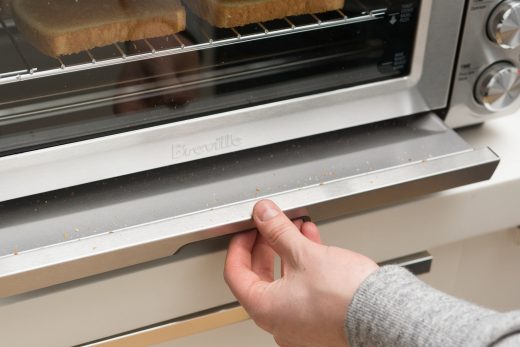The best toaster oven
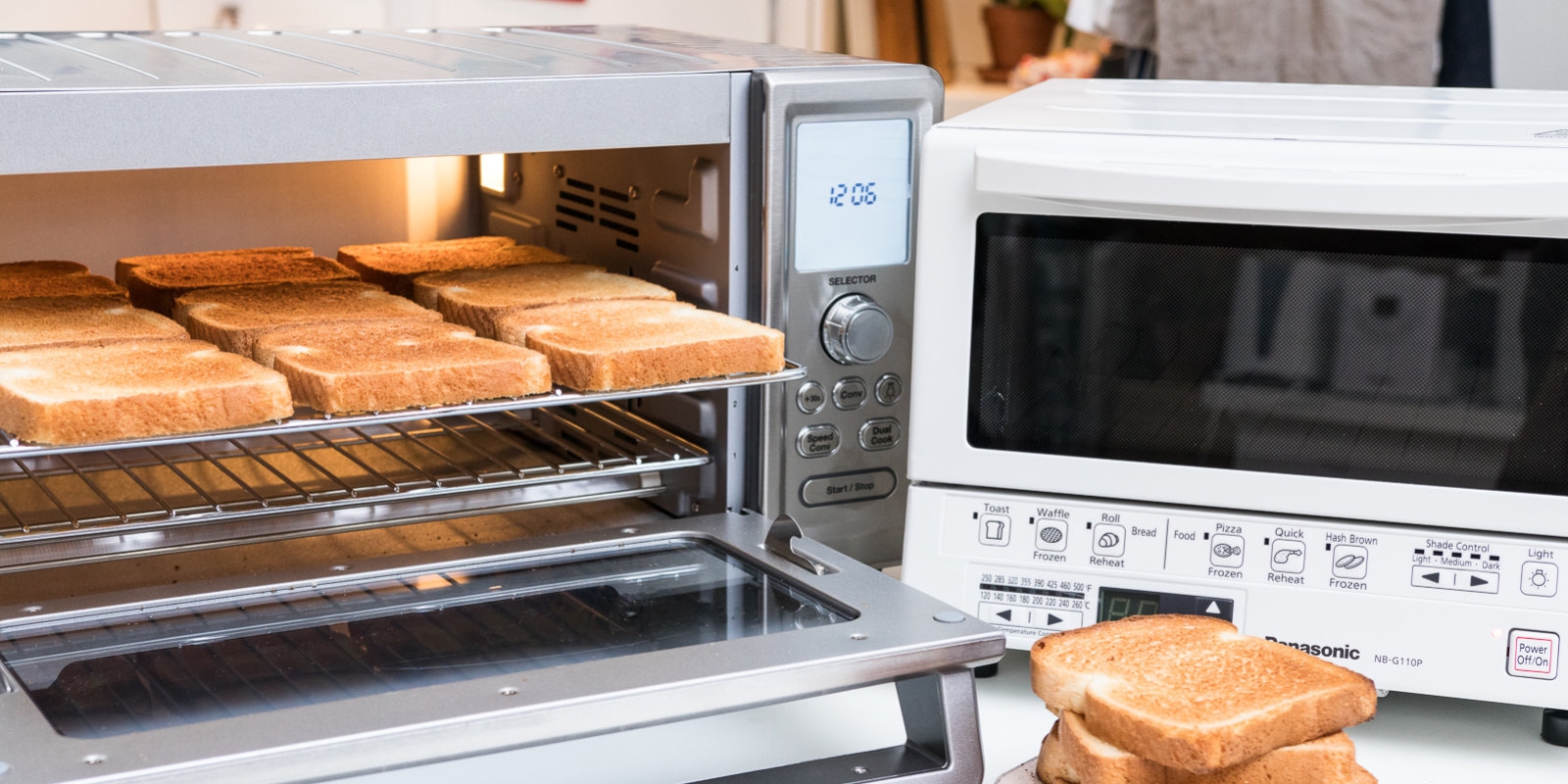
By Michael Sullivan and Brendan Nystedt
This post was done in partnership with Wirecutter. When readers choose to buy Wirecutter’s independently chosen editorial picks, Wirecutter and Engadget may earn affiliate commission. Read the full toaster oven guide here.
After more than 90 hours of research and testing—and making stacks and stacks of toast, mini pizza bagels, and cookies—we think the small Panasonic FlashXpress toaster oven and the large Cuisinart TOB-260N1 Chef’s Convection Toaster Oven are the best for most people. We recommend the compact Panasonic toaster oven only for small jobs like making frozen snacks, and the sizable Cuisinart toaster oven for everything, including bigger tasks, like baking a pizza or roasting a whole chicken. Both models consistently produced almost perfectly browned toast and evenly baked cookies. They performed as well as (or better than) toaster ovens costing two or three times as much.
The reasonably priced Panasonic FlashXpress excels at making toast, cookies, and frozen snacks. In our tests, it cooked food evenly and didn’t generate any hot spots that would otherwise cause inconsistent toasting. Impressively, it made toast faster than most of the other models we tried. At around 1 cubic foot in volume, it takes up very little space on a counter, but it’s still large enough to fit four pieces of bread or two slices of leftover pizza. We think the Panasonic is best for people who just want to use a toaster oven for toast or other small jobs, like preparing a handful of frozen snacks. For accomplishing bigger tasks, consider getting our other picks, the Cuisinart TOB-260N1 Chef’s Convection Toaster Oven or the Breville BOV800XL Smart Oven, which hold nine and six pieces of bread, respectively.
The large Cuisinart TOB-260N1 offers nearly all of the capabilities of a full-size oven. It delivers even heat to up to nine slices of bread and can easily handle a 13-inch frozen pizza or a whole roast chicken (whereas our other pick, the Panasonic FlashXpress, can fit only a handful of frozen snacks). The Cuisinart’s three-year warranty is outstanding, as are its impressive accessories, which include a pizza stone. Like the Panasonic, this toaster oven was one of the fastest at preheating to 350 °F in our tests. Since it’s so large (it measures roughly 20.5 by 13.25 by 11.25 inches), we recommend this model for bigger households that have ample space for a sizeable countertop oven.
The Breville Smart Oven BOV800XL, a 1,800-watt convection toaster with the company’s Element IQ technology, is a great medium-size model that’s more compact than our Cuisinart pick but bigger than the Panasonic FlashXpress. We were impressed by its ability to maintain a set temperature better than most of its competition. It doesn’t toast quite as evenly as the Cuisinart, but it bakes cookies and melts cheese well. Compared with the Panasonic, the Breville has a more modern, intuitive interface. However, it is more expensive, lacks an oven light, and doesn’t offer a pizza stone like the Cuisinart.
The inexpensive Hamilton Beach 31401 toasted bread better than any other toaster oven less than $100. This no-frills model lacks many of the features included in our other picks, such as digital controls and preset cooking features, but it heats evenly. Its humble size makes it ideal for kitchens with limited counter space, but its oven cavity is still large enough to fit four slices of bread. The Hamilton Beach runs cooler than other models we tested, so you’ll need to increase the temperature by about 25 degrees when baking or roasting. However, we think this is a forgivable drawback considering its low price.
Why you should trust us
To winnow down our selection of models to test we spoke with Martha Rose Shulman, cookbook author, food writer, and frequent contributor to The New York Times (parent company of Wirecutter). We also consulted reviews from America’s Test Kitchen (subscription required), Consumer Reports (subscription required), Serious Eats, and Good Housekeeping. Additionally, we looked at highly rated models on the sites of retailers such as Amazon, Sears, and Bed Bath & Beyond.
Michael Sullivan has spent more than 50 hours researching and testing toaster ovens for this guide. As a staff writer at Wirecutter, he has written reviews for all kinds of kitchen equipment and gadgets, including toasters. This guide builds on work by freelance writer Brendan Nystedt.
Who should get this
A toaster oven is a multipurpose appliance that lets you toast bread and bake or reheat food. It’s a nice alternative to firing up your full-size oven, especially in warmer months. It’s also great for small rentals that have tiny kitchens with an oven that doesn’t work well (or is missing altogether). If your kitchen is so active that the oven is full, you can use the toaster oven like Martha Rose Shulman, chef and author of The Simple Art of Vegetarian Cooking. When she runs out of room, she told us, she turns to the toaster oven to make gratins, lasagne, and sandwiches.
And what about regular old toasters? We have picks for those, too. In our original guide, Wirecutter strategy editor Ganda Suthivarakom likened a toaster oven to a passenger car and your big oven to an SUV: “Both are useful, and both will take you where you need to go, but the little car may be faster, more energy efficient, and more convenient for those shorter, smaller trips you commonly take.”
Toaster ovens can cost anywhere from $25 to $1,000, but we focused our search on those costing between $25 and $550. Wondering how much bang you’ll get for your buck? Here’s what each price level typically offers:
Under $100:
- Small-to-medium oven cavity (that can hold four pieces of toast or a few frozen snacks)
- Imprecise temperature regulation (usually)
- Manual controls and timer
- Fewer accessories (think one oven rack instead of two)
$100 to $250:
- Medium to large oven cavity (that can hold up to six or nine pieces of toast)
- Good temperature regulation (usually)
- Digital screen/electronic controls and timer
- Preset cooking functions (such as those for cooking pizza or frozen foods)
- More accessories (such as multiple racks and baking pans)
- An oven light
$250 and up:
- Everything you get from a $100 to $250 toaster
- Better temperature regulation
- Extra features (such as air frying modes and dehydrating modes)
How we picked
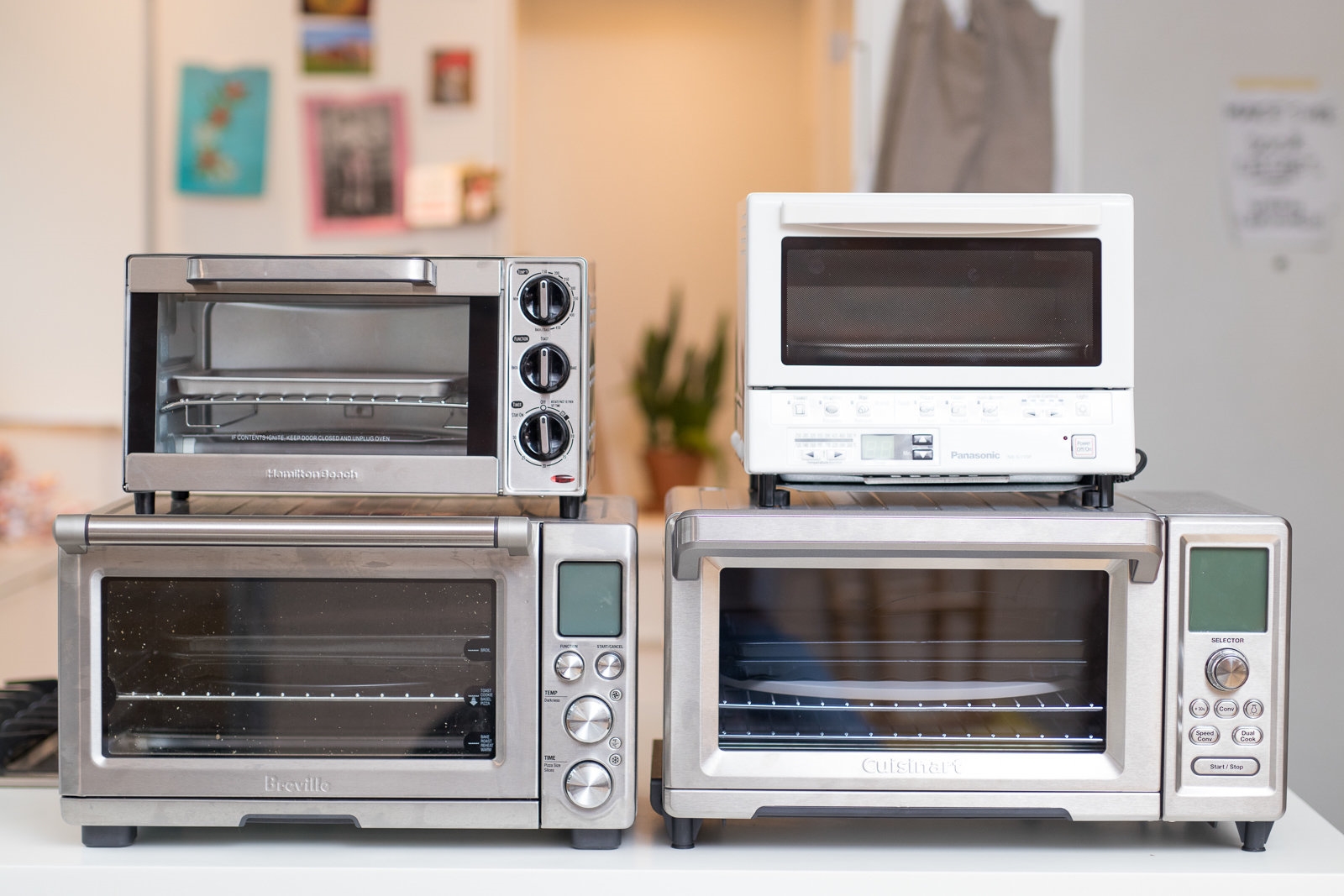
After speaking to our expert and spending years on our own long-term testing, we made a list of the most important qualities to look for when choosing a toaster oven:
Ease of operation: Aside from its performance, a good toaster oven should be intuitive to use with clearly labeled controls and an easy to read display. The most basic features should include adjustable temperature controls (ideally between 150 °F and 450 °F) and adjustable toast-shade settings.
Even heating: Several factors play a role in how evenly food cooks: the distance food is placed from the heating elements, the number of elements used, and the placement of the elements inside the oven.
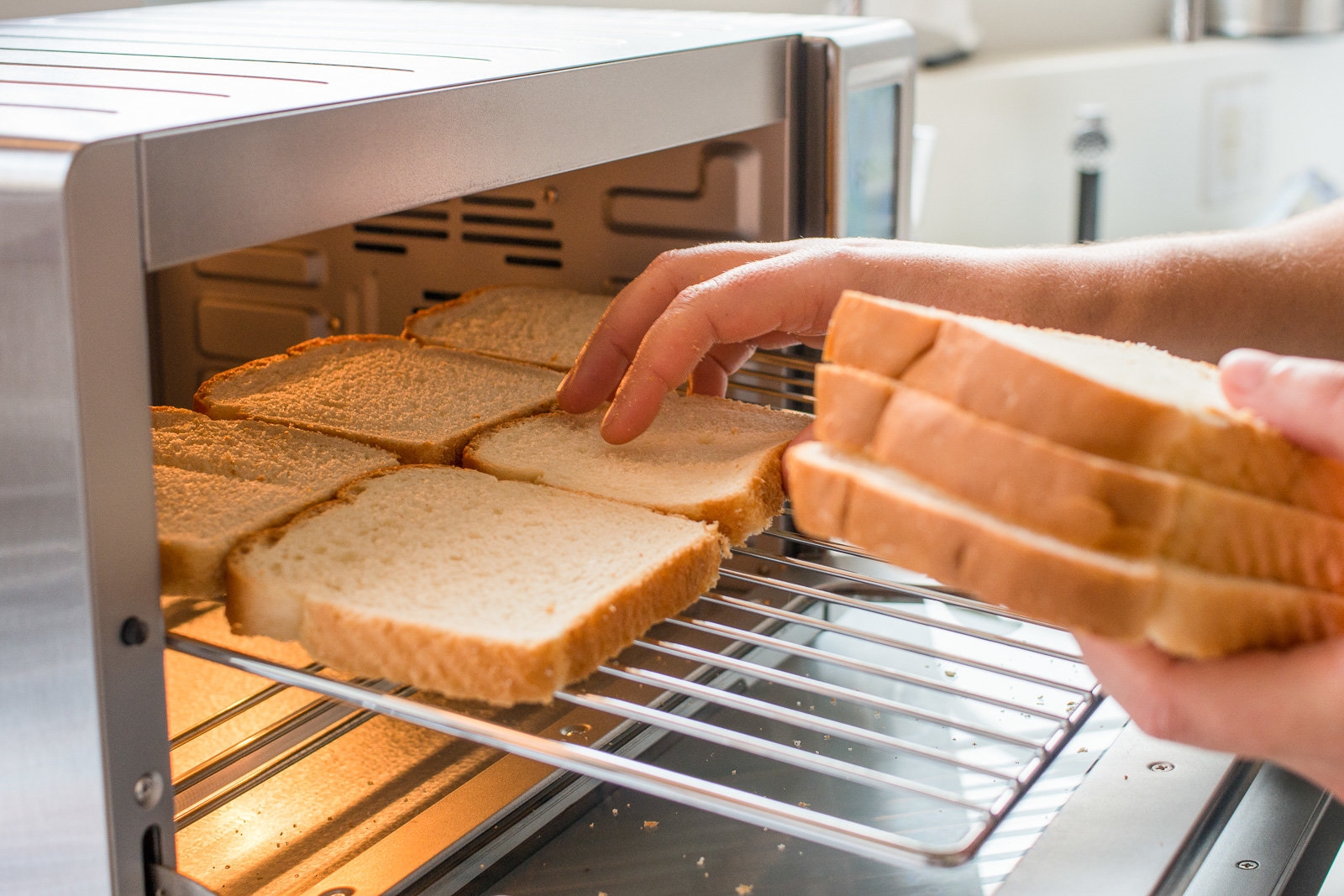
Some toaster ovens, like our budget pick, the Hamilton Beach 31401, are equipped with only two heating elements. But having fewer heating elements isn’t necessarily an indication of poor toasting performance. If the oven cavity is small, the unit doesn’t require additional elements to regulate heat. That being said, you want to avoid larger toaster ovens with only a couple of elements because they won’t be able to distribute heat evenly. The more heating elements a toaster oven has, the bigger and more expensive it will be.
While most people wouldn’t shop for a toaster oven by examining its heating elements, we focused on three main types during our research. Nichrome heaters (metal wires, like in a slot toaster) and quartz elements (which look like long coils encased in a glass tube) are the most common heating elements you’ll find in toaster ovens. The big advantage quartz has over nichrome is that it heats up considerably faster. The third type is a ceramic element, which is often found in space heaters. It has the ability to heat up quickly and maintain even temperatures. None of the models we tested use ceramic exclusively, but one model, the Panasonic FlashXpress, uses both quartz and ceramic. The type of heating elements used in toaster ovens don’t necessarily correlate to price. For instance, our budget pick costs less than $50 but has the same quartz elements as the Cuisinart, which costs more than $150. And the Wolf countertop oven we tested, which costs about $550, uses nichrome elements, which are typically found in cheaper models.
Reasonable size: We looked at a range of toaster ovens in various sizes. Some people want a small oven for simple tasks like making toast or baking snacks and cookies. Others may prefer a larger unit akin to a countertop oven to cook a 12- or 13-inch pizza or roast a whole chicken. Keep in mind, a large toaster oven can be pretty heavy and is more cumbersome to move around your kitchen, which means it’s more likely live on your counter. Small toaster ovens are much lighter and easier to tuck away in a cupboard. We recommend choosing a toaster oven with a capacity large enough to accomplish your cooking needs, but small enough to fit the confines of your kitchen.
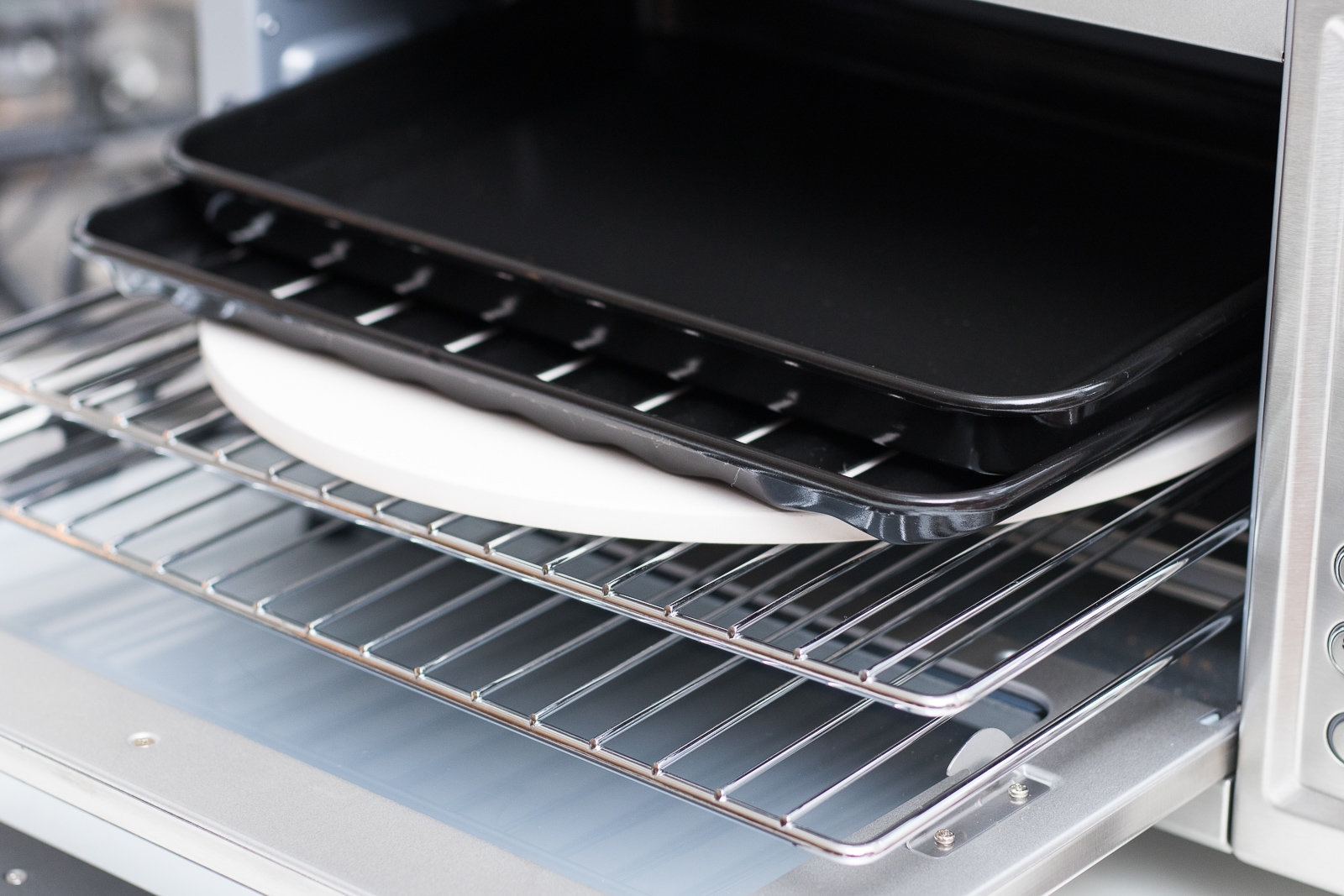
Useful accessories and extra features: Most toaster ovens come with the same basic accessories: a crumb tray, an oven rack, and a baking pan. More expensive models typically offer multiple oven racks and additional pans, such as broiling and pizza pans. A crumb tray is absolutely necessary to catch crumbs and grease. But if you already have a quarter baking pan that fits the dimensions of your toaster oven, you may not find some of these other accessories very useful. However, most toaster ovens have unusual dimensions that don’t fit standard baking pans, so it’s nice that they’re included. If you want to purchase extra oven racks or baking bans, most manufacturers sell these separately online.
A reliable timer and an oven light are nice additions but not necessary. Other features, like automatic cooking modes and racks that pull out when you open the door, are also convenient. Some features are less clearly valuable—we saw everything from toaster/toaster-oven crossbreeds to models with rotisseries built in. Ultimately, we focused our search on models that were able to handle baking, toasting, and other standard tasks well.
One feature that manufacturers like to tout is convection, which basically means that a fan will circulate the hot air inside the oven. Convection has a benefit in full-size ovens, where it can reduce cooking times, but it’s not clear how useful it is in small ovens, as Consumer Reports and Serious Eats note. We did our own test to see how break-and-bake Toll House cookies differed when baked using a convection setting versus a standard setting. The convection-baked cookies were crispy on the outside and slightly undercooked in the center, while the conventionally-baked cookies were crispy on the outside and soft on the inside. However, the results didn’t leave us feeling one method was superior to the other. We didn’t consider convection a must-have feature when we selected models to test (though nearly all high-end models include it).
We also looked at smart toaster ovens, such as the exorbitantly priced June Oven, which boasts an HD camera that monitors your food as it cooks, carbon fiber heating elements, and two convection fans. (Ultimately we don’t think these high-tech, high-price ovens are worth buying, which we discuss in our guide to the June).
Sufficient warranties: Regardless of price, most toaster ovens offer a standard one-year warranty. One exception is the Cuisinart TOB-260N1 (one of our top picks), which was the only model we tested that came with an impressive three-year warranty.
How we tested
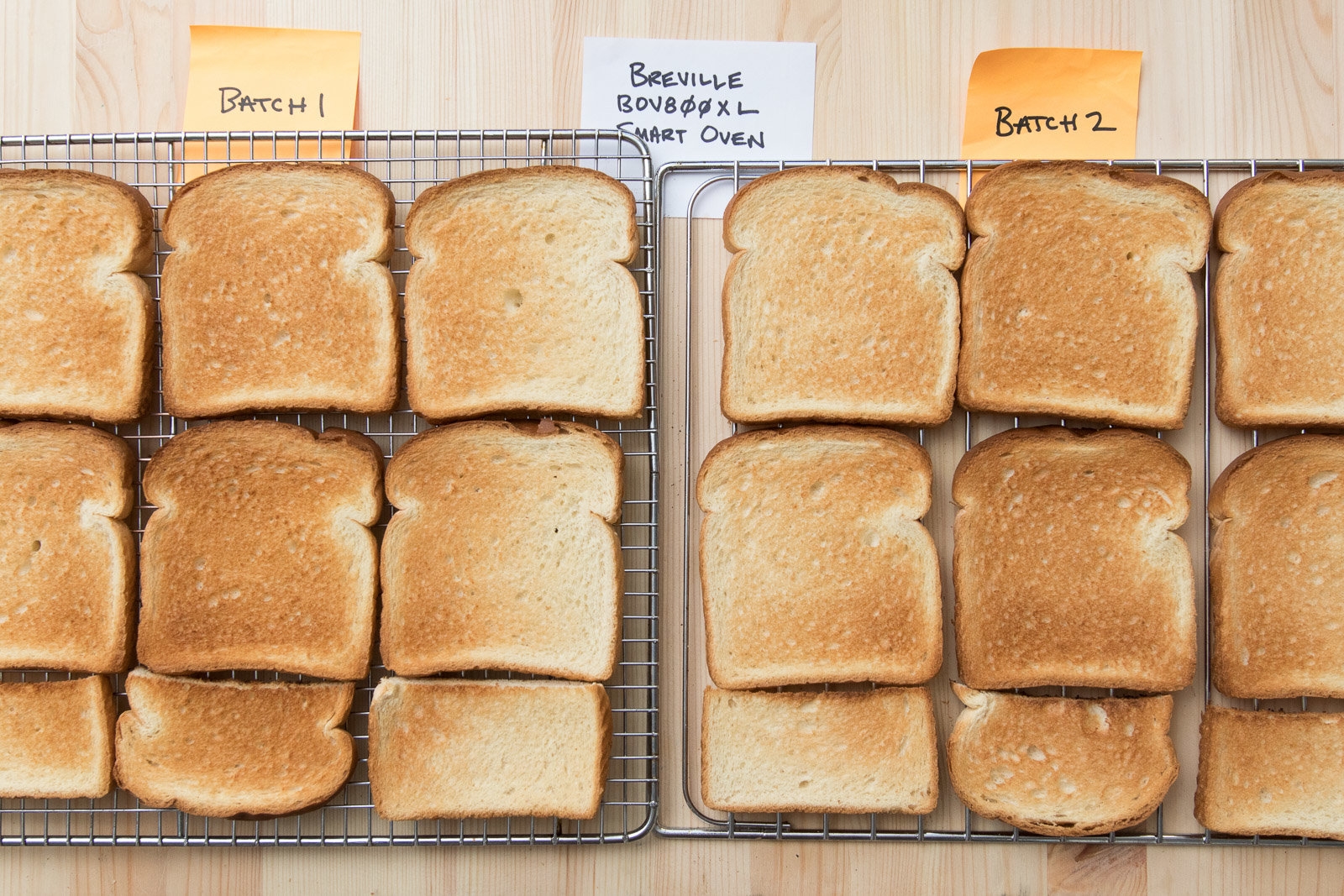
For our 2018 update, we put 11 toaster ovens through a battery of tests in our New York City test kitchen. First, we filled each toaster with as many slices of basic white bread as we could. For consistency, we set each machine to the medium shade setting and used the toasted results to create a heat map. This showed us any hot spots, and how evenly each oven toasted.
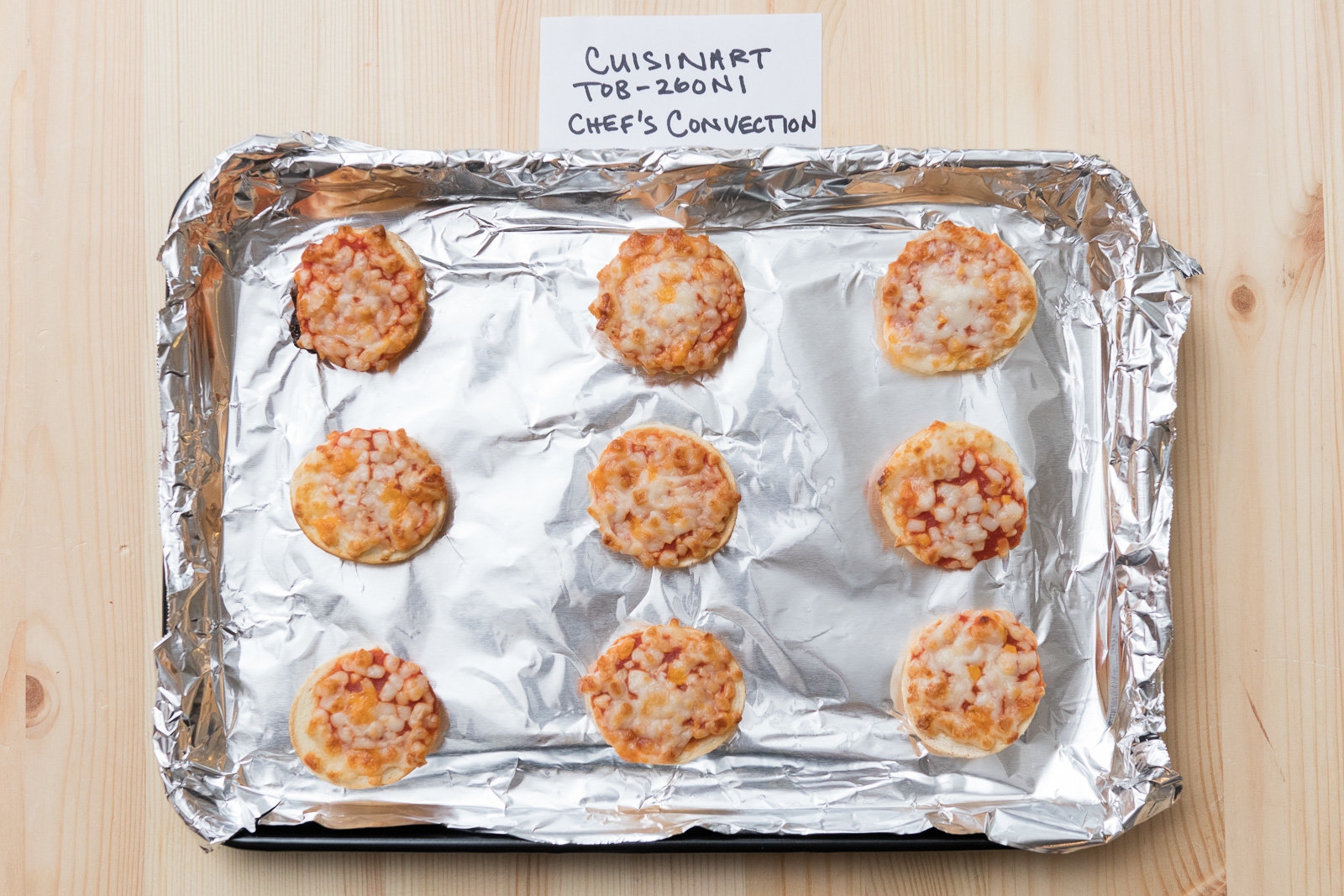
We also made break-and-bake Toll House cookies, evaluating the finished cookies for color, consistency, and texture: Were they evenly baked? Or were they underdone or burnt? Additionally, we made pizza Bagel Bites, keeping an eye on how browned the cheese was, whether or not the cheese effectively melted, and how crunchy the bagel got on the underside. To even the playing field, we didn’t use the convection setting on any of the models we tested.

In 2015, we also ran a bonus round of testing on chicken thighs. We wanted to evaluate the effectiveness of each oven’s broil mode, if it had one. The results were disappointing on every single model, so don’t expect much from this feature, even if the oven can roast and bake with no problem.
To test how well the toaster ovens maintained a set temperature, we stuck an air probe thermometer into their cavities and monitored them for 20 minutes. We also tested the unique features on certain models, such as the air fry and dehydrate modes on the Breville Smart Oven Air. Additionally, we took note of any excessively loud beeps and evaluated the usefulness of each model’s accessories.
The best small toaster oven: Panasonic FlashXpress
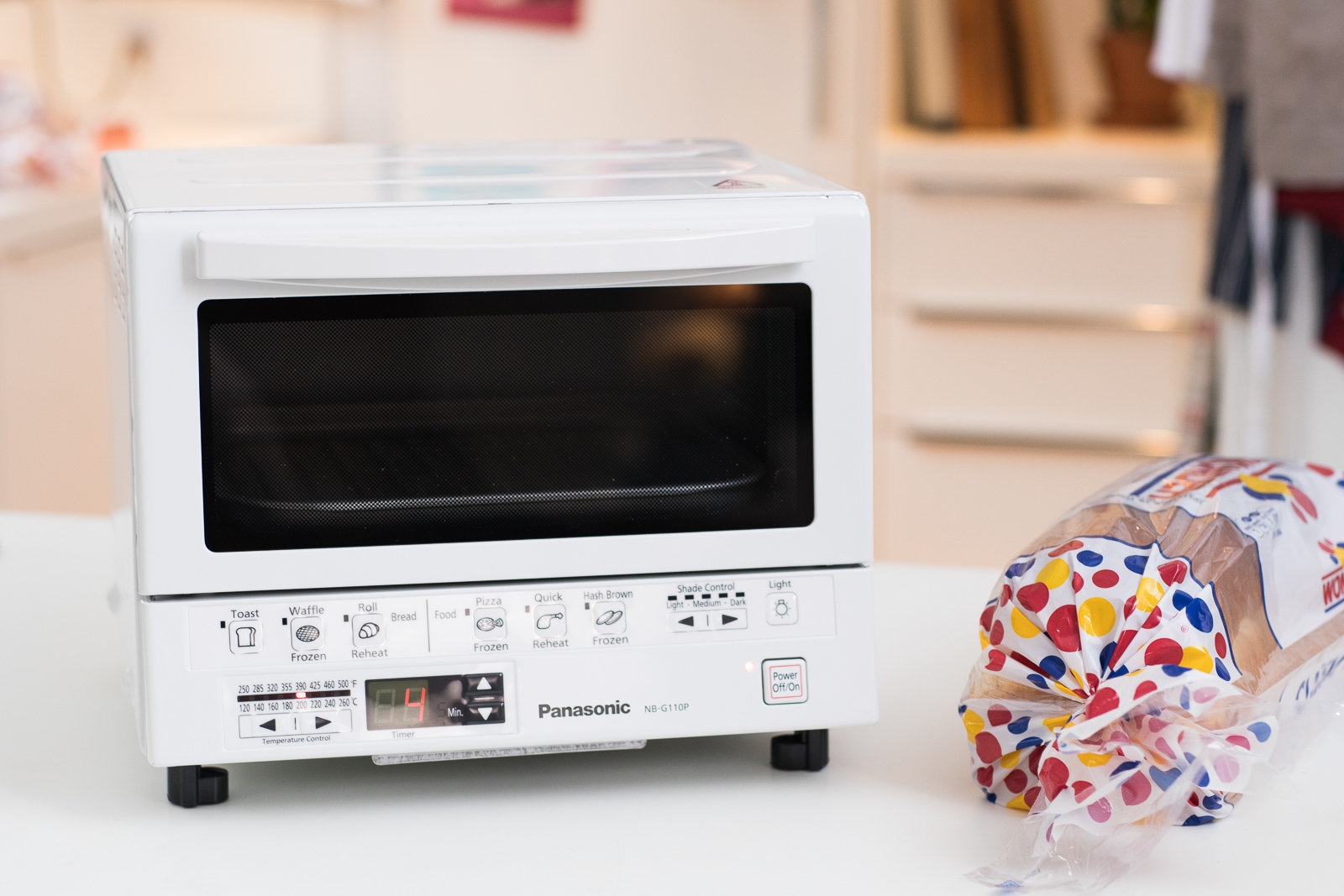
We recommend the Panasonic FlashXpress for those who want a small model for making toast, preparing a few frozen snacks, or reheating a couple slices of pizza. We were impressed with its strong baking performance, compact size, and reasonable price. It cooked foods to an even, lovely golden brown better than most other models we tried, and its toast shade settings were among the most accurate we tested. For a relatively low price, the FlashXpress stands out from a crowded pack of mediocre, cheap models, offering performance and features we found comparable to toaster ovens that are larger and double the cost.
Bread toasted on the medium setting came out beautifully golden brown without any scorching or charring. Other models we tested, such as the KitchenAid KCO273SS, toasted bread unevenly, with extreme light and dark patches. Most toaster ovens get hotter with every batch of toast you make, which can quickly leave you with charred pieces of toast if you’re not closely watching. The FlashXpress compensates for the increased temperature by automatically reducing the cook time so the results are the same every time. In our tests, the first batch of toast took about 2 minutes, 30 seconds, while the second and third batches took 2 minutes, 4 seconds and 1 minute, 20 seconds, respectively. These were some of the fastest toasting times of all the toaster ovens we tested.
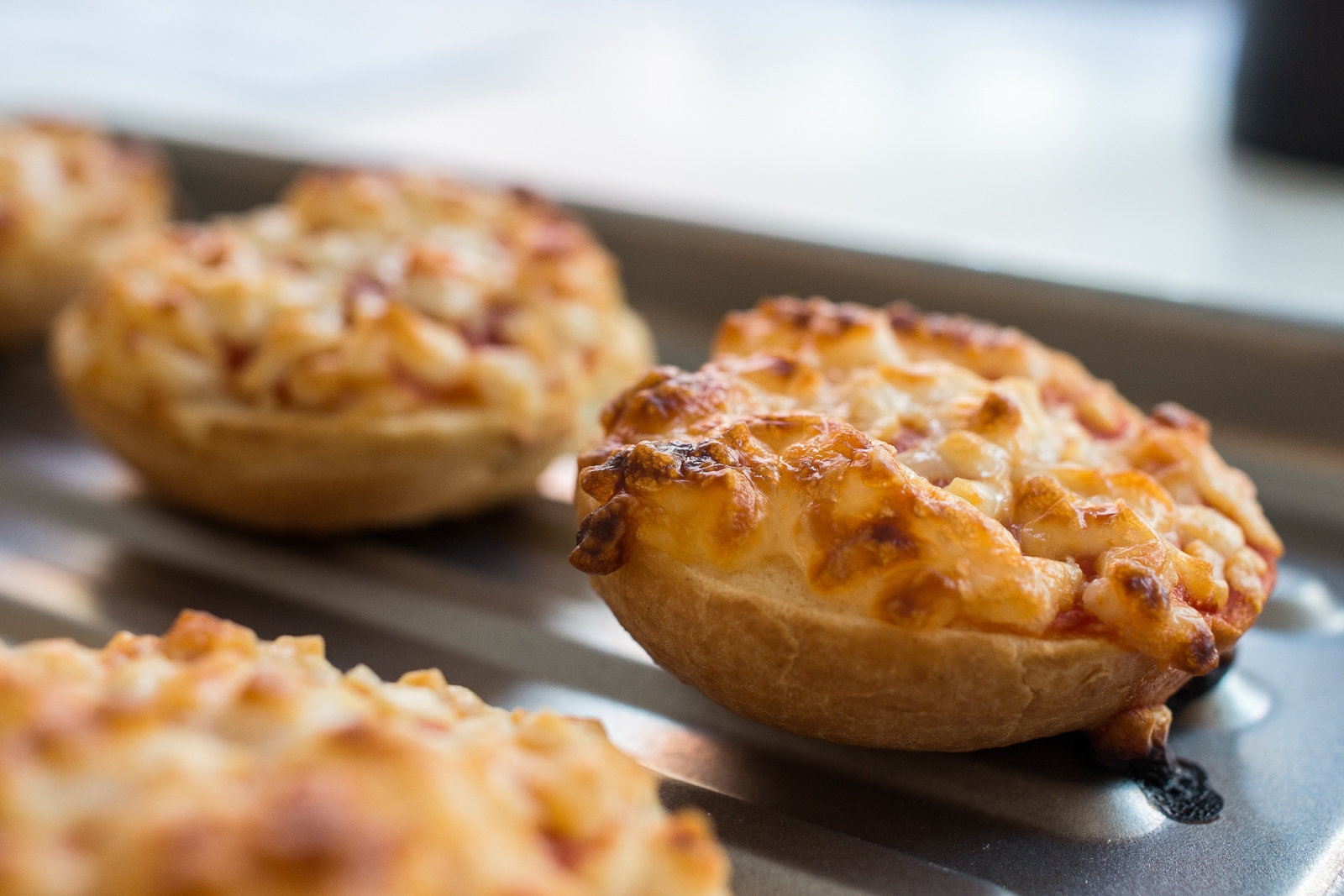
The FlashXpress made crispy-yet-melty Bagel Bites that were more consistently browned from one edge of the oven cavity to the other. Some ovens’ results weren’t dark enough; others put out too much heat or had hot spots in the center. Up against bigger, more expensive toaster ovens, the FlashXpress more than held its own.
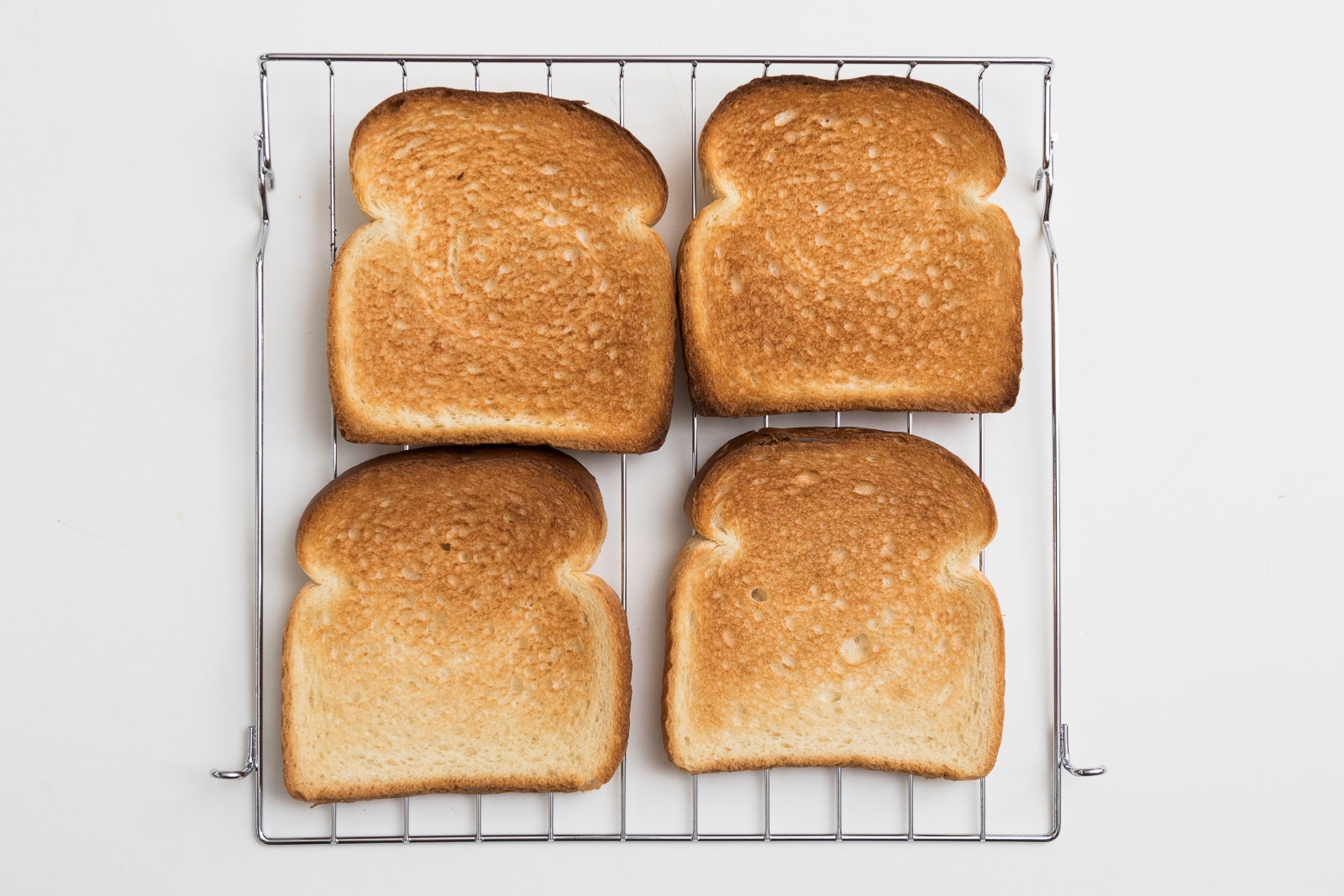
The FlashXpress was one of the smallest toaster ovens we tested, so it’s a great option for those with limited counter space (it measures a bit more than one cubic foot at 13.5 by 13.5 by 14.5 inches). It takes up only a little more space than most four-slot pop-up toasters and fits four pieces of bread (compared with up to nine in our other top pick, the Cuisinart TOB-206N1). You can’t cook a casserole or a loaf of bread in this toaster oven, but there’s still plenty of space for items like leftover pizza, frozen waffles, and cookies.
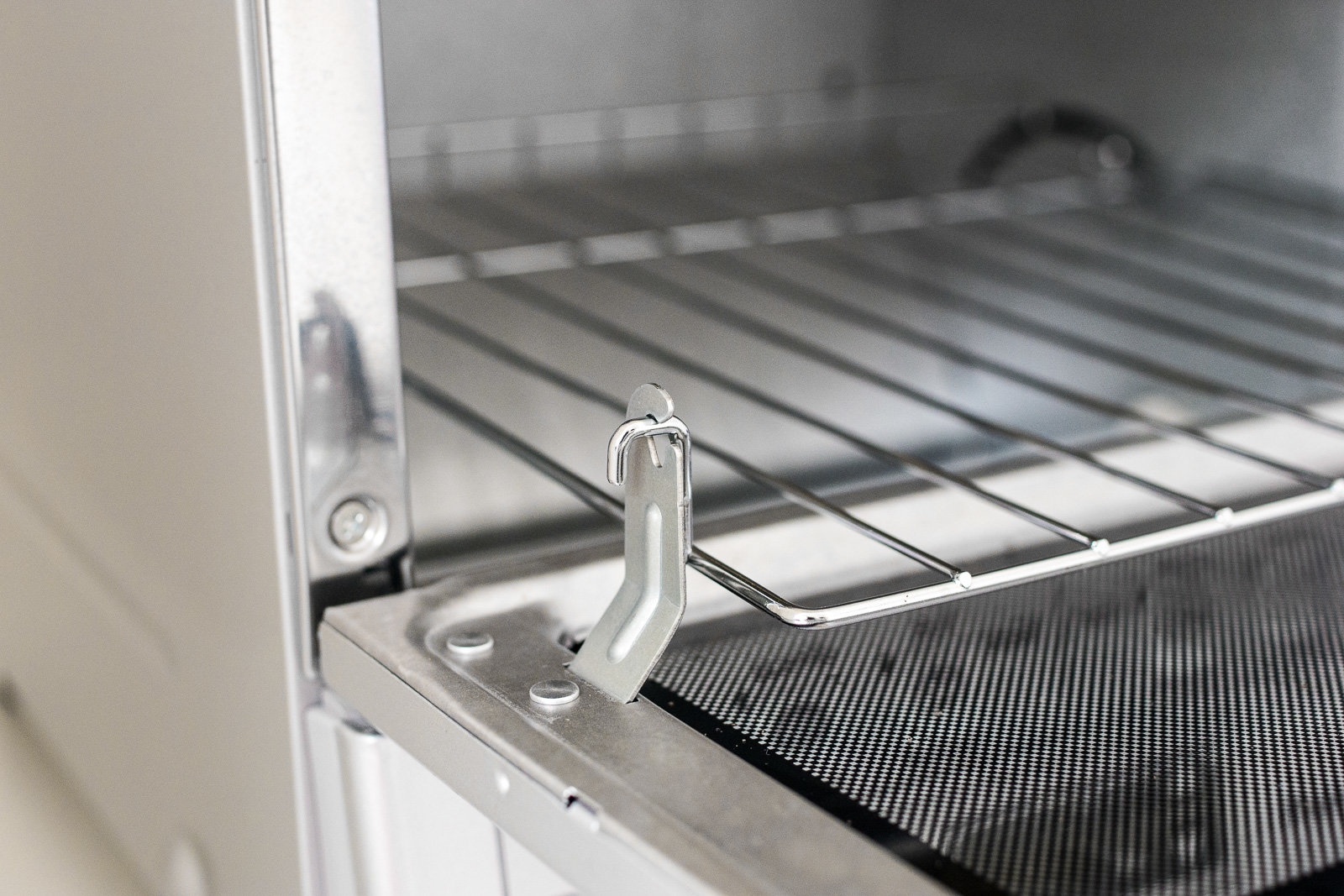
Beyond performance, there are other features that set the Panasonic FlashXpress apart from the competition. Hooks on the door help eject the toaster’s wire rack so you don’t have to reach your hand as far into the oven cavity to retrieve your food. Though this feature was common with some of the larger, more expensive models we tested, the Panasonic FlashXpress was one of the few to include door hooks at a lower price.
We also liked that the Panasonic FlashXpress beeps when the cycle has finished and turns itself off automatically. This model also has an oven light, which is rare for toaster ovens at this price level. According to the manual, preheating isn’t necessary. However, we’d still recommend waiting a couple of minutes for the unit to preheat for best results.
A “newer model” of the FlashXpress (the PAN-NB-G110PW) is listed on Amazon, but it is just a white version of the same toaster oven.
Flaws but not dealbreakers: Panasonic FlashXpress
We’d hesitate to describe the Panasonic FlashXpress’s interface design as being elegant, but it presents a straightforward cooking experience with its clearly labeled controls. Unlike the other toaster ovens we recommend that have dial controls, the Panasonic has blister-push buttons for all but the power switch. The buttons are perfectly usable—not as sticky and mushy as others we tested—but a dial would be preferable.
Using a retro red LED display, the Panasonic FlashXpress’s timer looks more like a time bomb from a 1990s action thriller than a modern kitchen appliance. While it’s not hard to read the display dead-on, it can be tricky to discern from off angles. We found that the displays on the pricier Cuisinart and Breville toaster ovens were easier to read.
Additionally, the Panasonic FlashXpress, as a Japanese appliance, is understandably designed around degrees Celsius for temperature input. There’s a converted-to-Fahrenheit selector on the temperature indicator, but the markings are oddly spaced. Want to punch in 400 °F? You can get either 425 °F or 390 °F but nothing between. That said, this idiosyncrasy didn’t negatively impact any of the items we cooked.
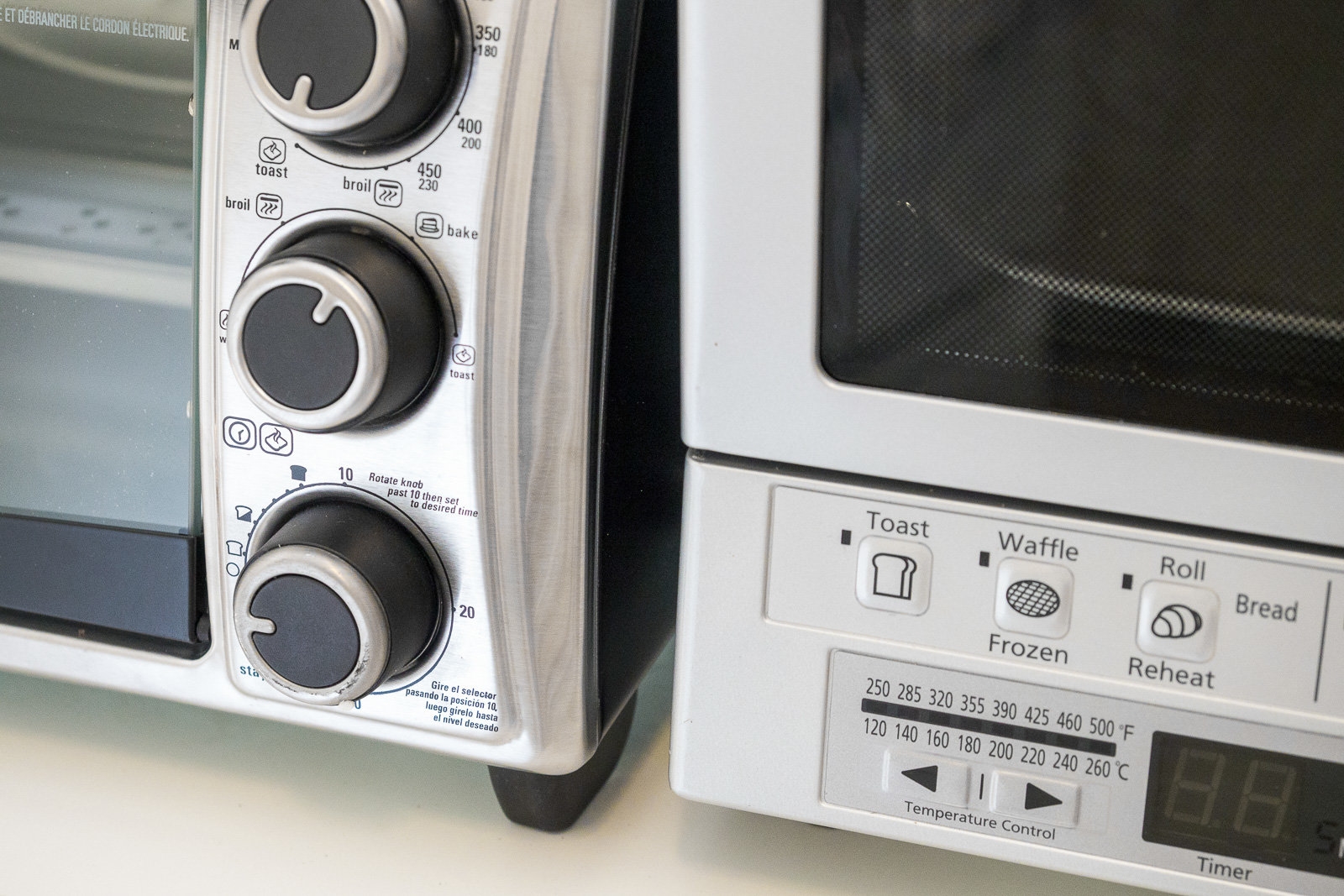
Another quirk of the FlashXpress is that the oven light turns on and off periodically throughout the cooking process, because the rear heating element doubles as the light. We didn’t find this to be particularly annoying, but it’s something to be aware of before you buy.
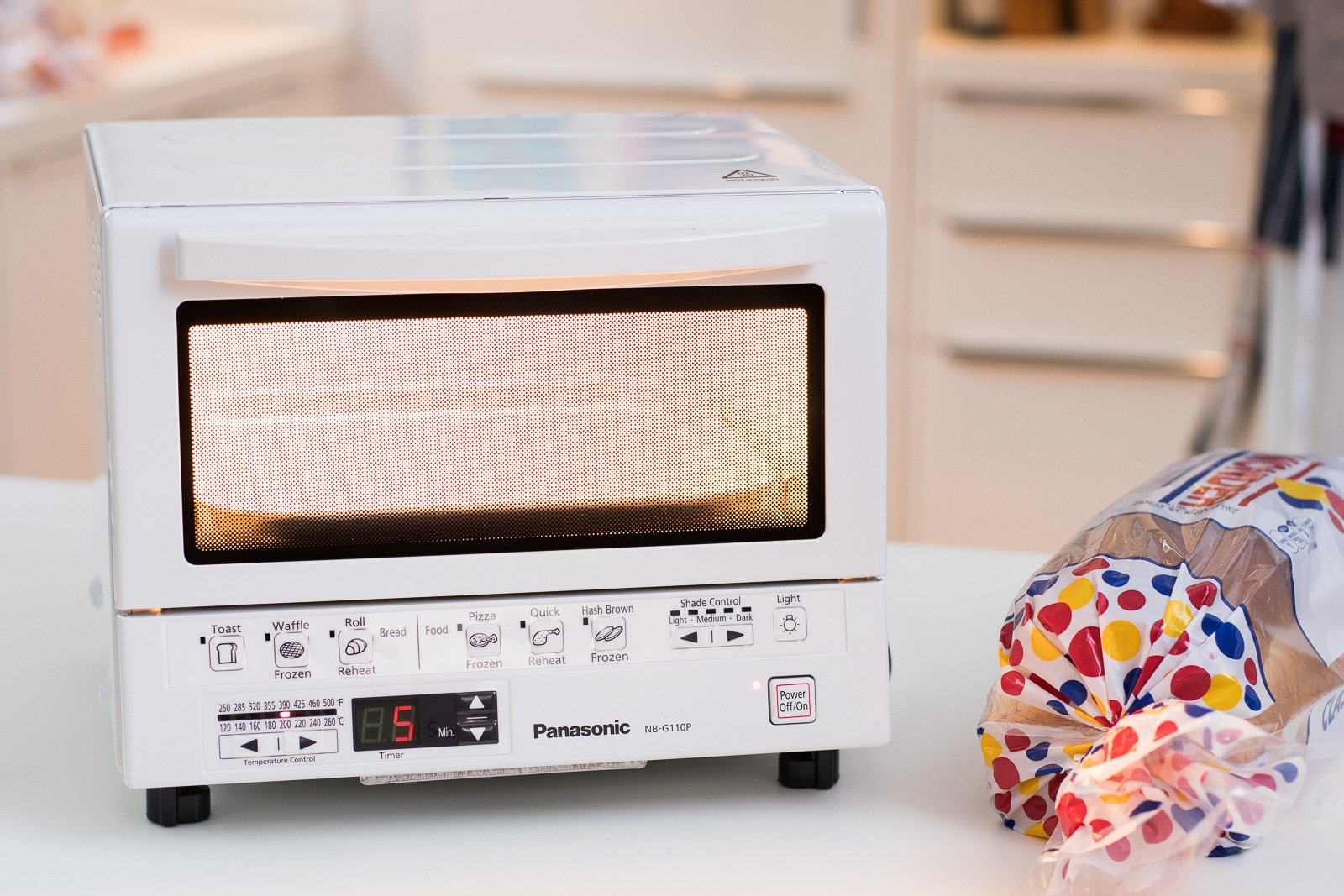
When mapping out the Panasonic’s internal heat distribution, we found a 1-inch margin right behind the door where the toast didn’t brown well. Since you can’t fit full slices of bread in that space anyway, it’s not a huge deal (just remember to push your bread all the way to the back of the oven rack). However, it did affect other foods that were in that zone. While Bagel Bites and cookies placed in the cool area were thoroughly cooked, they weren’t as pleasantly browned. But similar problems were common in many of the ovens we tested.
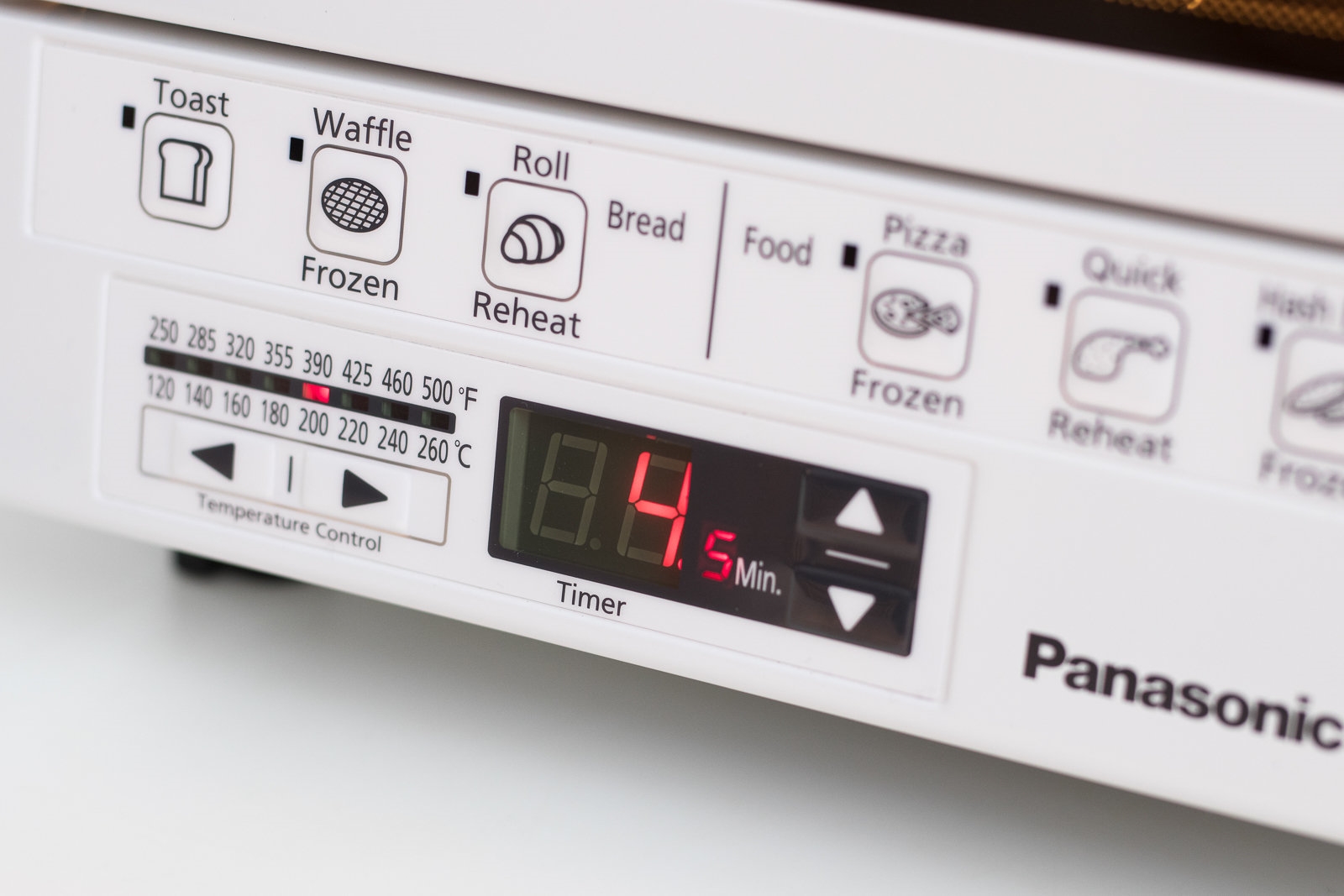
Also, the Panasonic FlashXpress has a somewhat flimsy stamped-metal crumb tray compared with the sturdier trays of our other picks. After only a few cycles, the Panasonic tray was already warped. However, the warping didn’t make it overly difficult to pull or clean the tray.
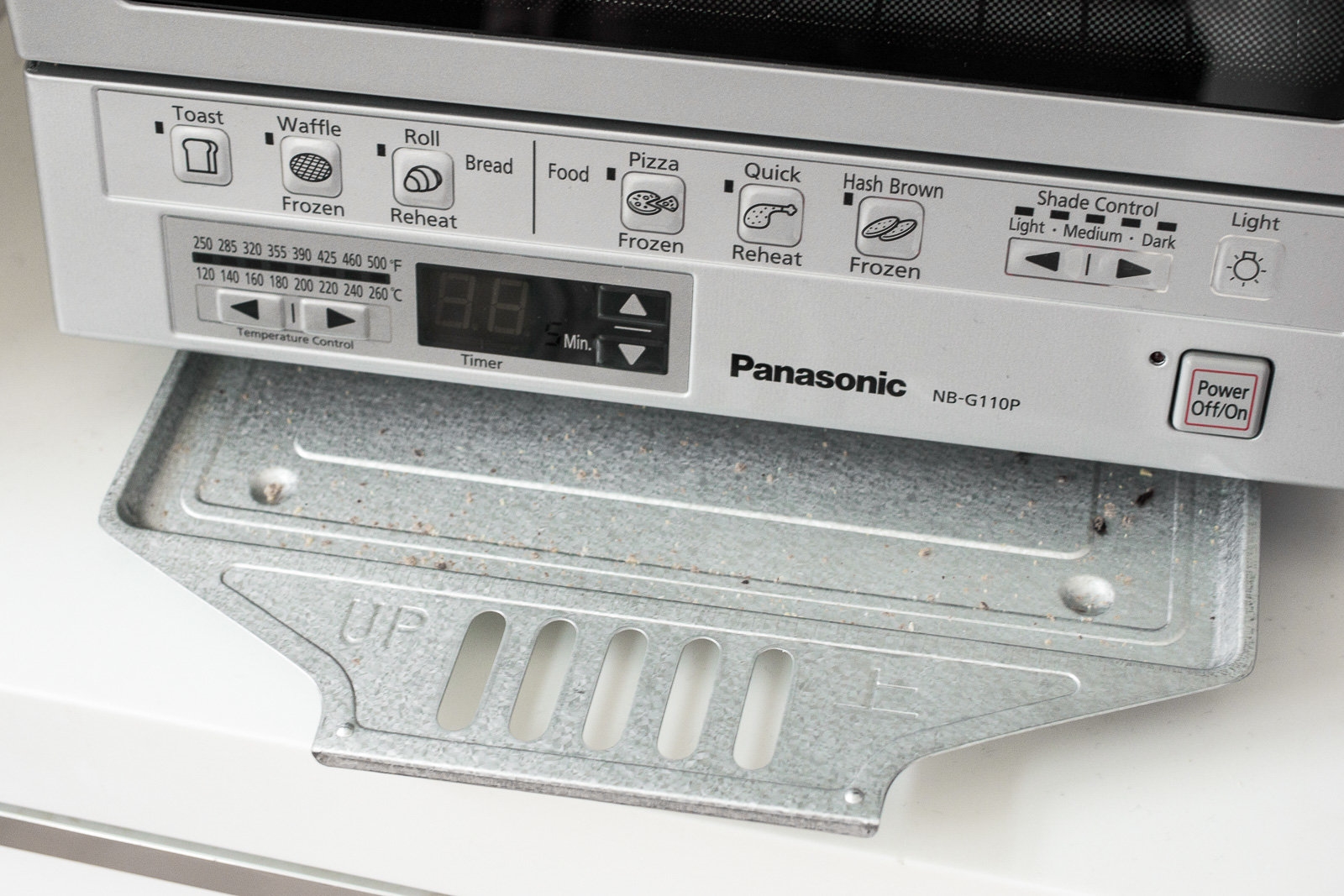
Should you encounter any problems with the FlashXpress under its one-year warranty, contact Panasonic.
The best large toaster oven: Cuisinart Chef’s Convection Toaster Oven
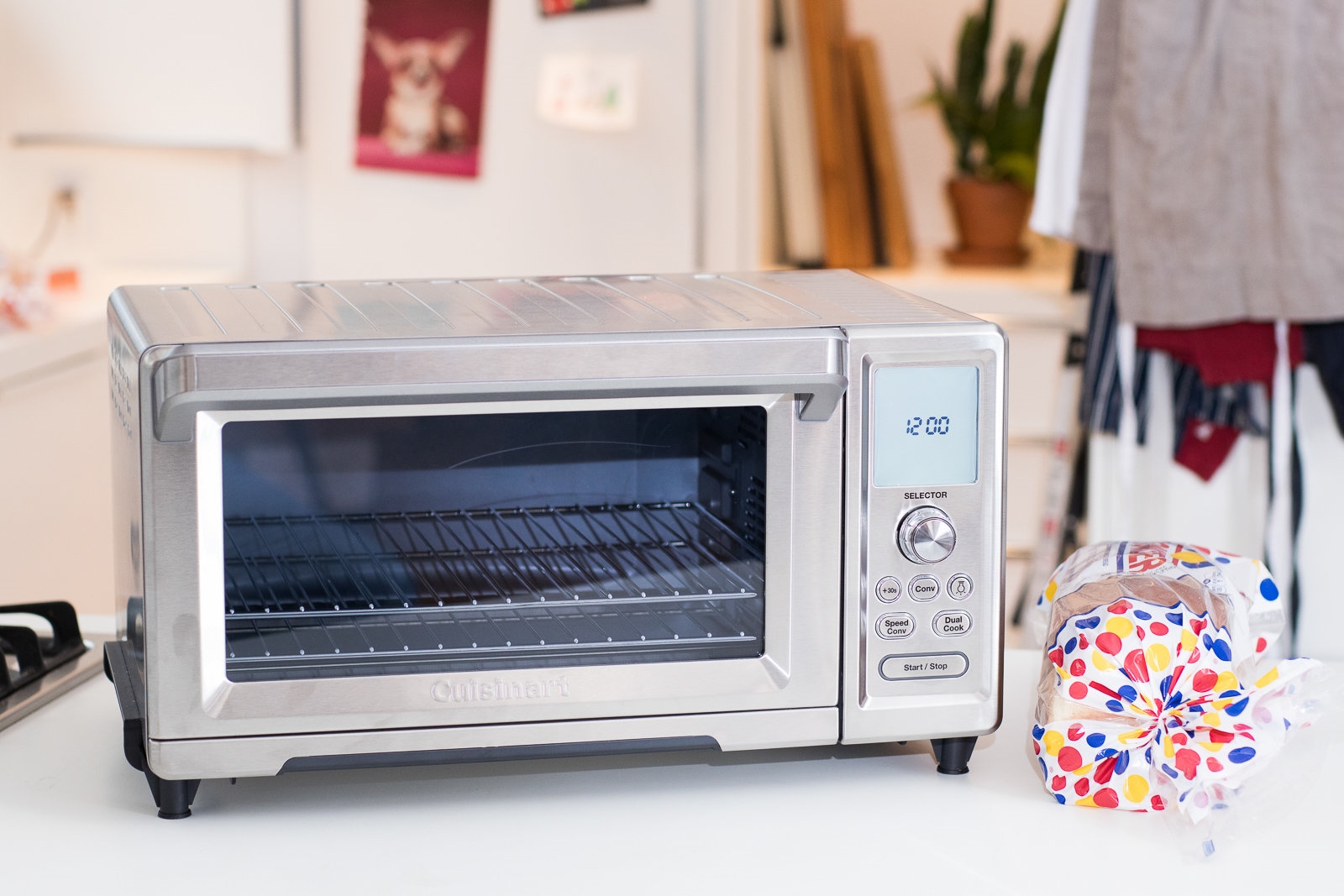
The versatile Cuisinart TOB-260N1 is one of the best toaster ovens that we’ve found for bigger jobs, like cooking a 13-inch pizza, roasting a whole chicken, or toasting up to nine slices of bread at once. This model is a different beast entirely than the Panasonic FlashXpress (our pick for the best small toaster oven): It’s almost twice the size, and its much bigger oven cavity can handle a wider variety of cooking tasks. The Cuisinart toasted bread more evenly than the other toaster ovens we tried at this price level. It also has a better warranty, more accessories, and one of the shortest preheating times of all the models we tested.
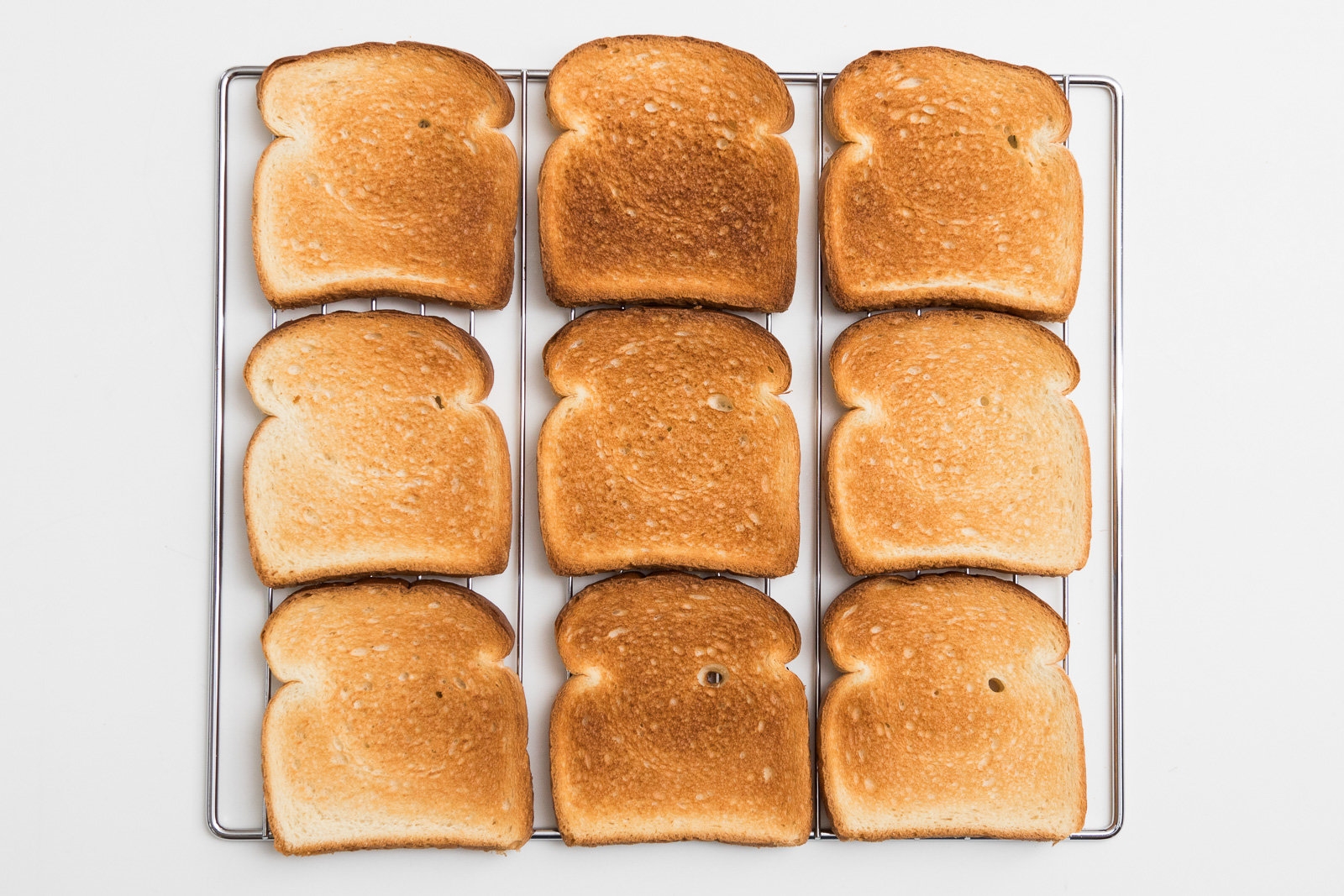
Without a doubt, the Cuisinart distributed heat evenly across its voluminous cavity, toasting nine slices of bread in a single batch to near golden-brown perfection. Corner to corner, no other oven was as consistent (aside from the exorbitantly priced Wolf Gourmet Countertop Oven). Similarly priced large toaster ovens (like ones from Breville and KitchenAid) both concentrated heat in the center of the oven and had a more significant fall-off of heat toward the edges.
The Cuisinart comes with a number of accessories: two racks, a baking pan, a broiling tray, and a ceramic pizza stone. After years of long-term testing, the pizza stone continues to make crisp, golden-brown pizza crust. Most of the other competitors we saw at this price level come with only a single rack and a flimsy metal pizza pan, so the extras with the Cuisinart feel like a step up. The oven cavity is also wide enough to fit a standard quarter-sheet tray. The Cuisinart has four slots for the racks, with metal hooks that pull out the middle rack when the door is opened. It was one of the fastest models to preheat to 350 °F, taking just over 3 minutes.
The Cuisinart has one unusual feature we didn’t see with any other toaster oven: a setting called dual mode. It’s a basic way of programming your own cooking cycle by hooking two existing modes together to play out back-to-back. So, let’s say you’re baking a couple of cinnamon rolls. Using dual mode, you could, for instance, bake them to perfection, and then run a 15-minute warming cycle automatically after they’re done cooking while you wait for your family to get out of bed.
The Cuisinart has a three-year limited warranty, while most competitors include just one-year warranties for the same price. Contact Cuisinart for repairs or a replacement.
Flaws but not dealbreakers: Cuisinart Chef’s Convection Toaster Oven
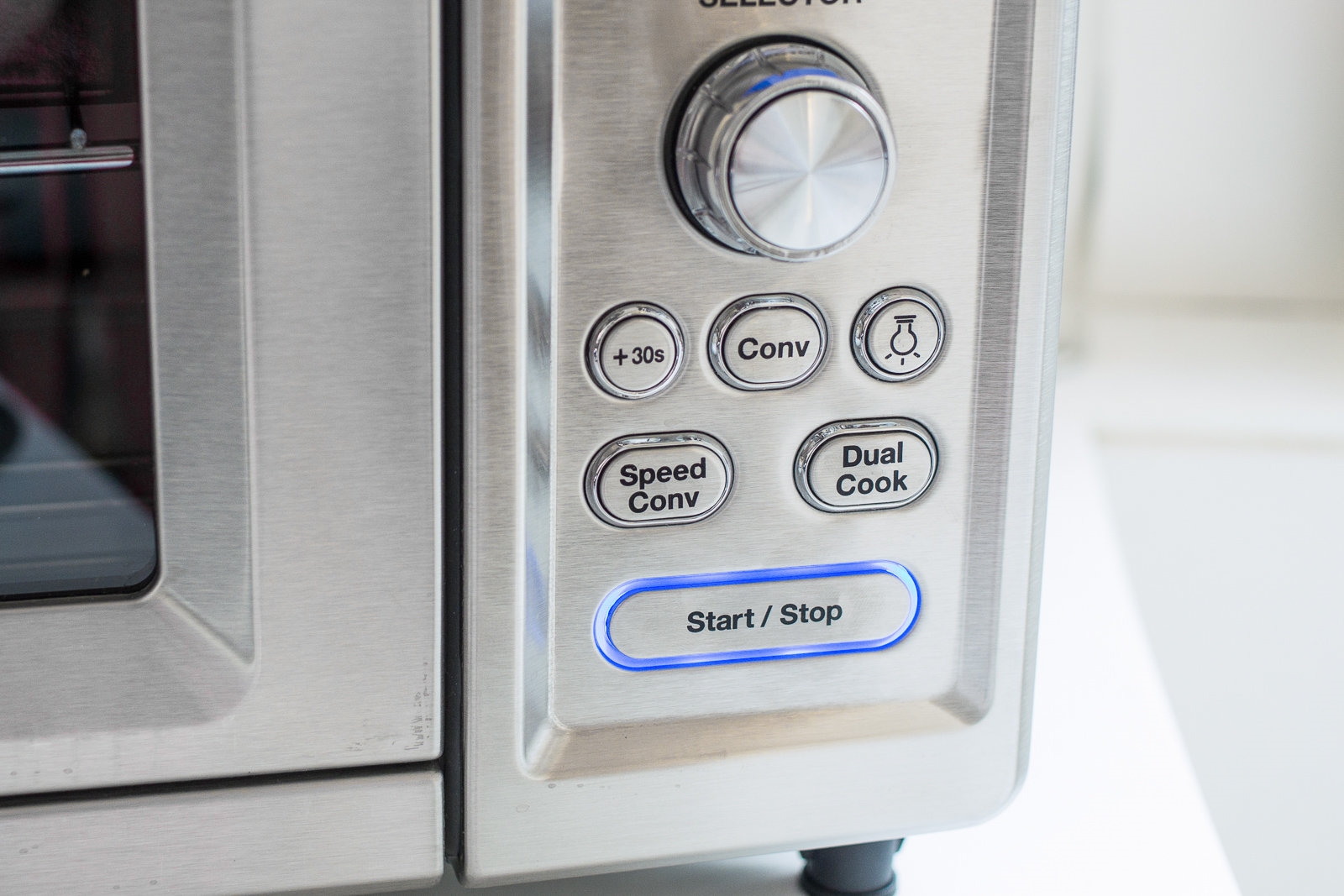
The biggest shortcoming on the Cuisinart is the single dial control, which functions as a combined start/stop button and timer. It’s not as intuitive as the two-knob controls on the Breville Smart Oven, but once we familiarized ourselves with it, we appreciated its sleeker, pared-down interface.
Also, we found the middle shade setting for toasting (setting 4) to be a bit too dark. We recommend using setting 3 for making perfect golden-brown toast.
Long-term testing notes: Cuisinart Chef’s Convection Toaster Oven
Writer Michael Sullivan had the gas shut off in his apartment building for nearly four months and used the Cuisinart TOB-260N1 for doing everything from baking cakes and cookies, to roasting whole chickens and quarter-sheet trays of vegetables. After a year and a half of persistent use, it’s still going strong.
Runner-up: Breville Smart Oven
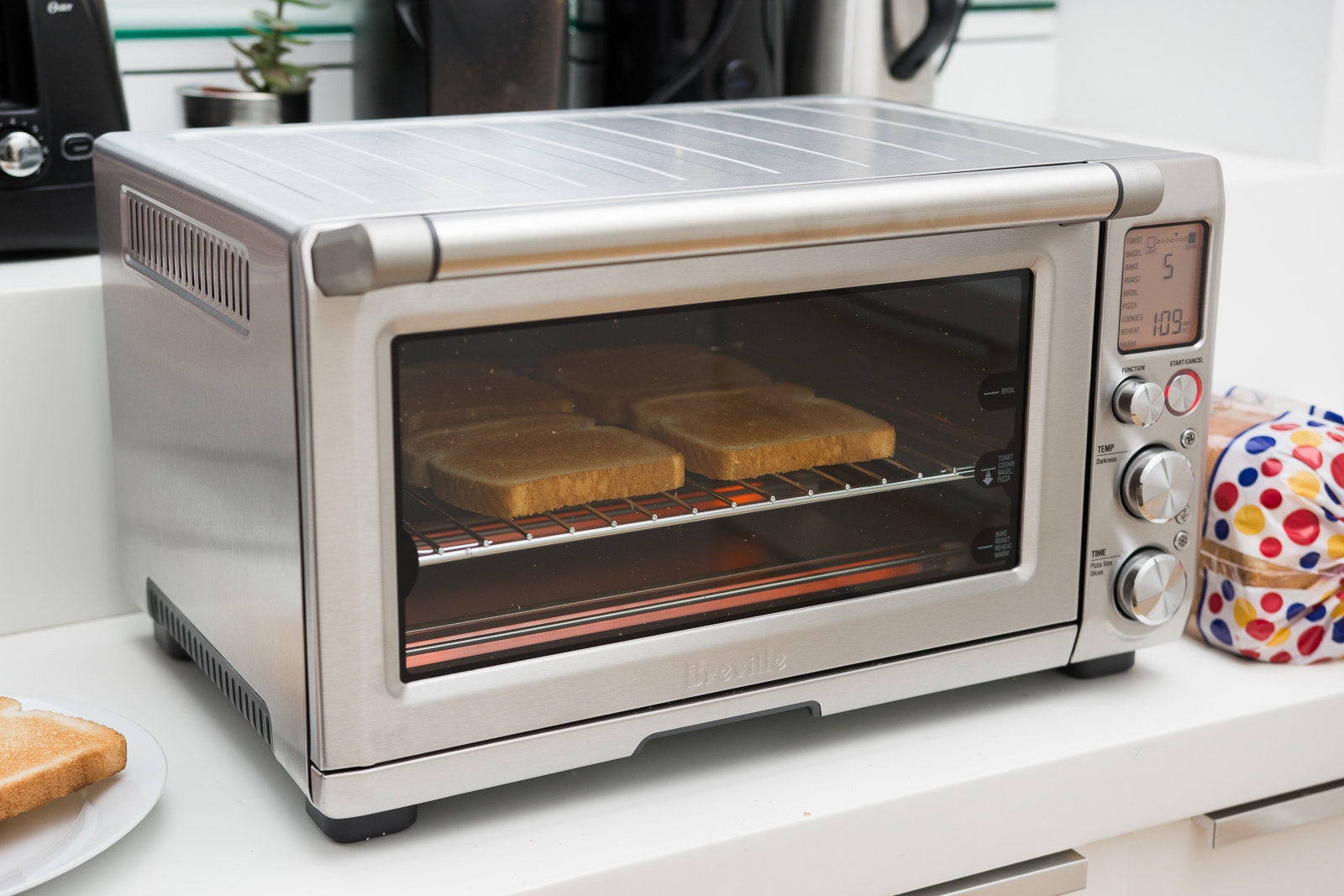
The medium-size Breville Smart Oven has all of the functionality of our larger main pick, the Cuisinart TOB-260N1, but has a slightly smaller footprint. This model did well in our tests, toasting bread almost as evenly as the Cuisinart. However, it’s slower to preheat and lacks an internal light. That said, we appreciated the Breville’s intuitive interface, easy-to-read display, and ability to regulate heat well. Since the Breville didn’t surpass the Cuisinart in our tests and costs significantly more, we recommend it only if you prefer its medium size.
The Breville Smart Oven toasted bread evenly from front to back, with paler results from side to side, but it still toasted more evenly than the Breville Smart Oven Pro and the Hamilton Beach 31230. The Breville Smart Oven can fit up to six slices of bread or a 12-inch pizza. (We found that six slices of bread toast best on heat setting 4, while one to four slices toast best on heat setting 6.)
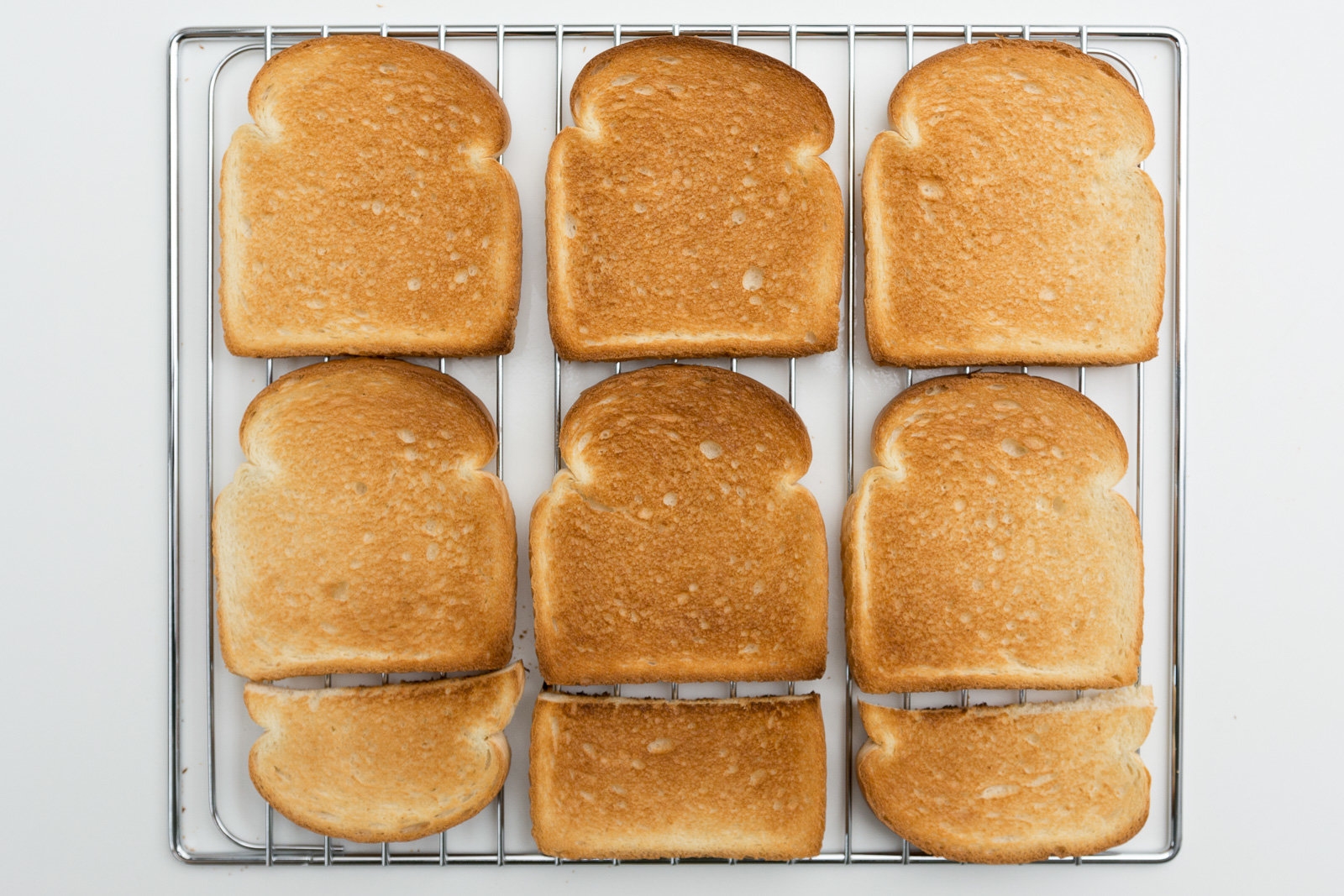
The Breville Smart Oven comes with several accessories, too: a single rack, a baking pan, a broiler pan, and a non-stick pizza pan. Though we preferred the pizza stone from the Cuisinart over the round metal pan from the Breville Smart Oven, it’s still a nice addition for baking frozen pizza. The oven is also wide enough to fit a standard quarter sheet tray. Additionally, we liked the magnets on the Breville Smart Oven that glide the rack out when opening the door, making it easier to retrieve hot items.
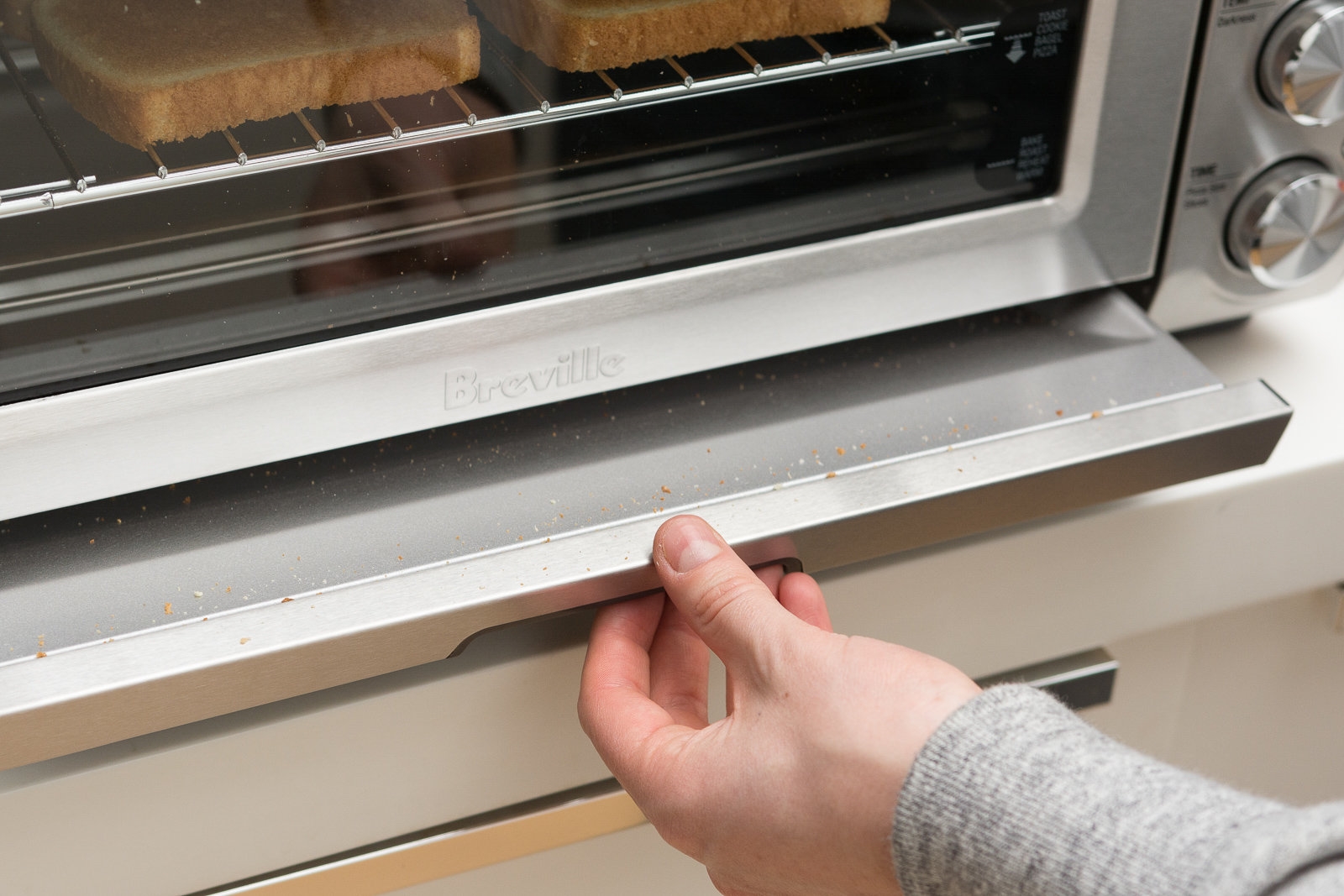
Of all the toaster ovens we tried, this model has the easiest-to-use controls. In fact, we understood how the controls worked without having to refer to the user manual, which wasn’t the case with the Cuisinart. The legend displayed on the door also conveniently tells you where to place the rack for broiling, toasting, and baking.
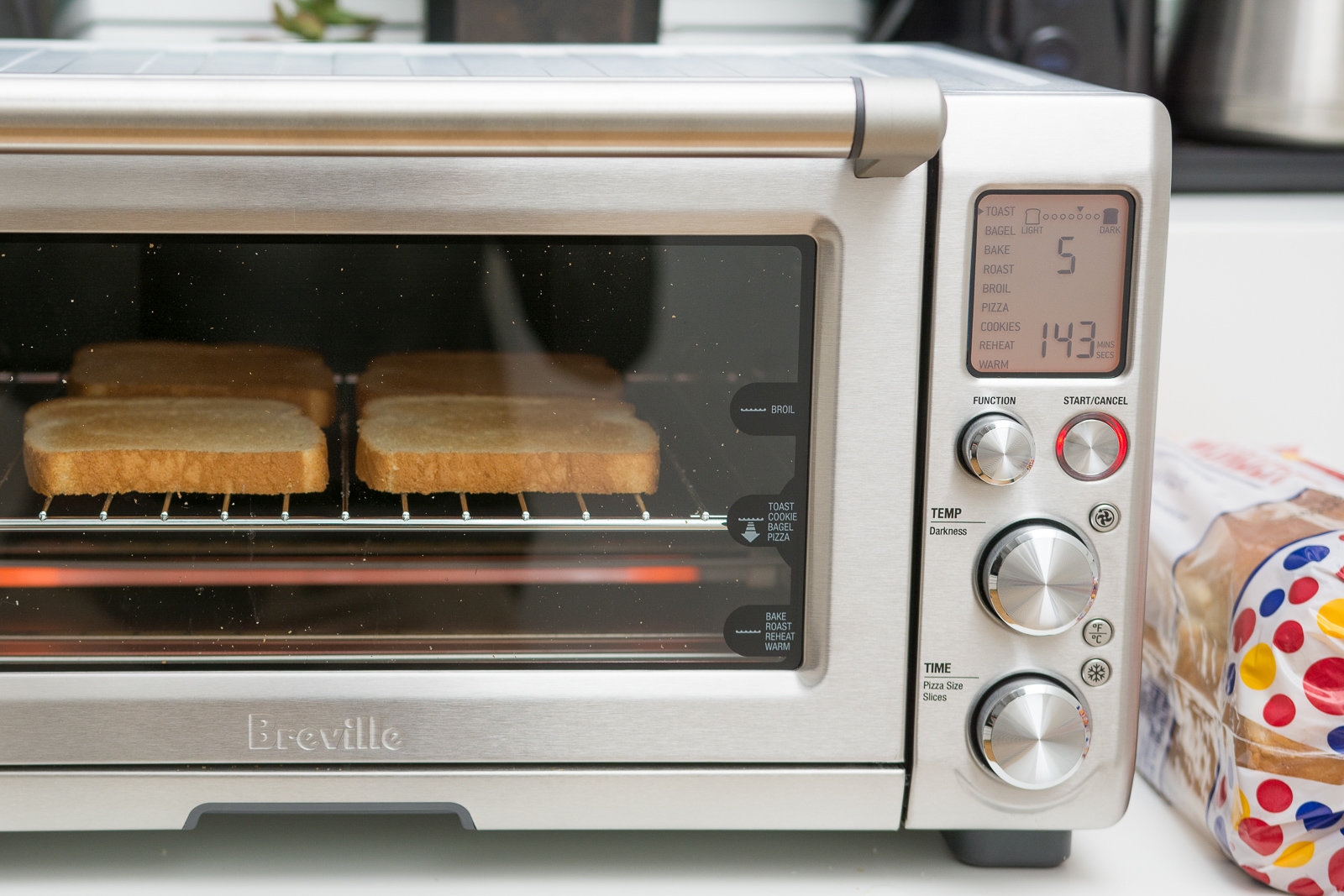
One glitch is that the convection mode automatically activates whenever you adjust the function knob. To deactivate this mode, you have to press the convection button each time to turn it off. This is a little annoying, but we don’t consider it a dealbreaker since this model is so easy to use and provides solid results. Also, the Breville doesn’t have an internal light, but we found that the heating elements provide enough illumination for you to see inside to check your food.
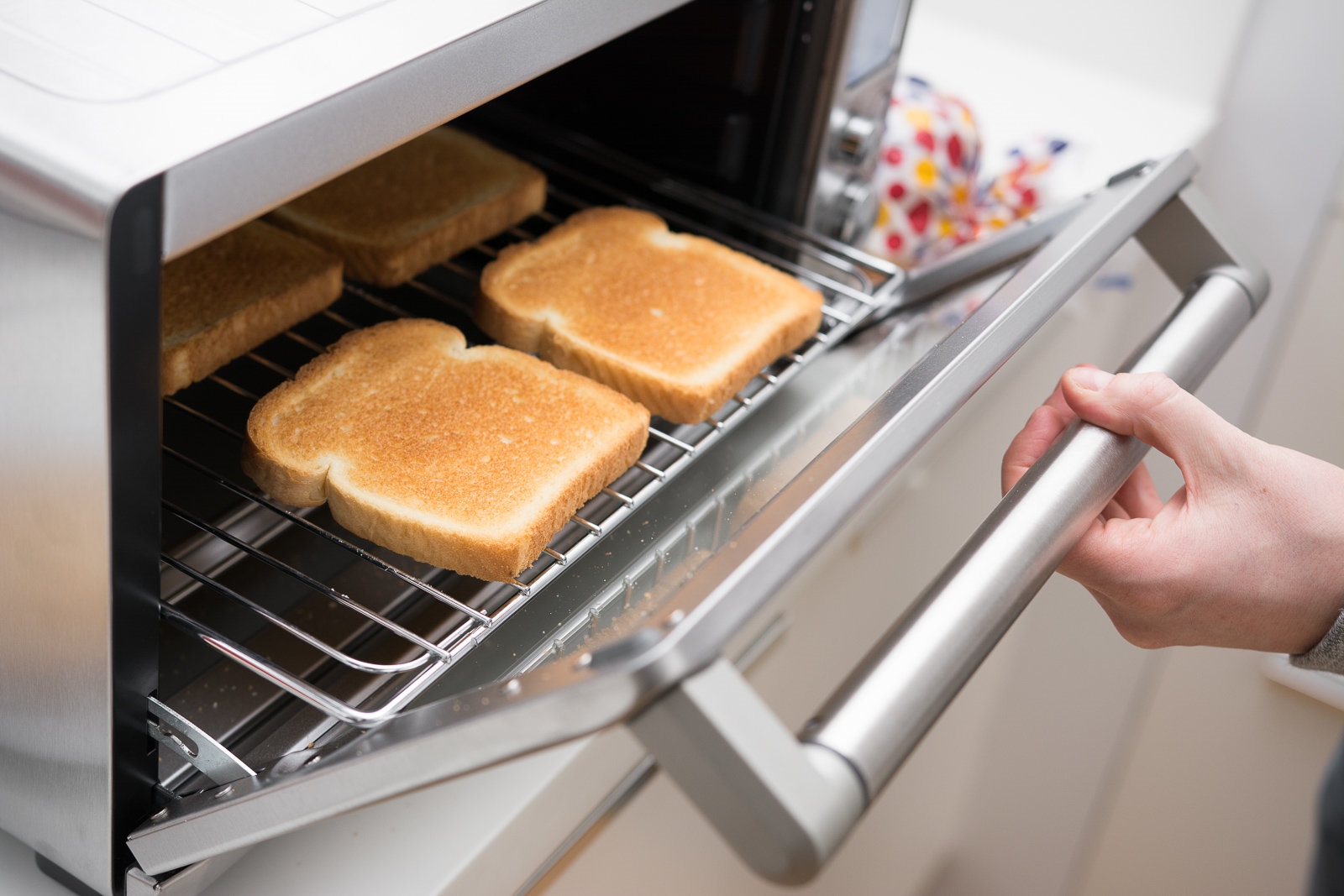
The Breville is backed by a one-year limited warranty, which isn’t as good as the Cuisinart’s three-year warranty. Contact Breville for repairs or a replacement.
Long-term testing notes: Breville Smart Oven
Wirecutter kitchen writer Lesley Stockton, who has owned the Breville Smart Oven for about two years, said, “I use it almost daily for a wide range of cooking applications like toast, baked potatoes, small fruit tarts, and finishing steaks and chops. It’s a lifesaver in the summertime because my conventional oven turns our apartment into a hot box during the sweltering months. I’ve burned through four toaster ovens over the course of my adult life, and the Breville is by far my favorite.”
Budget pick: Hamilton Beach 4 Slice Toaster Oven
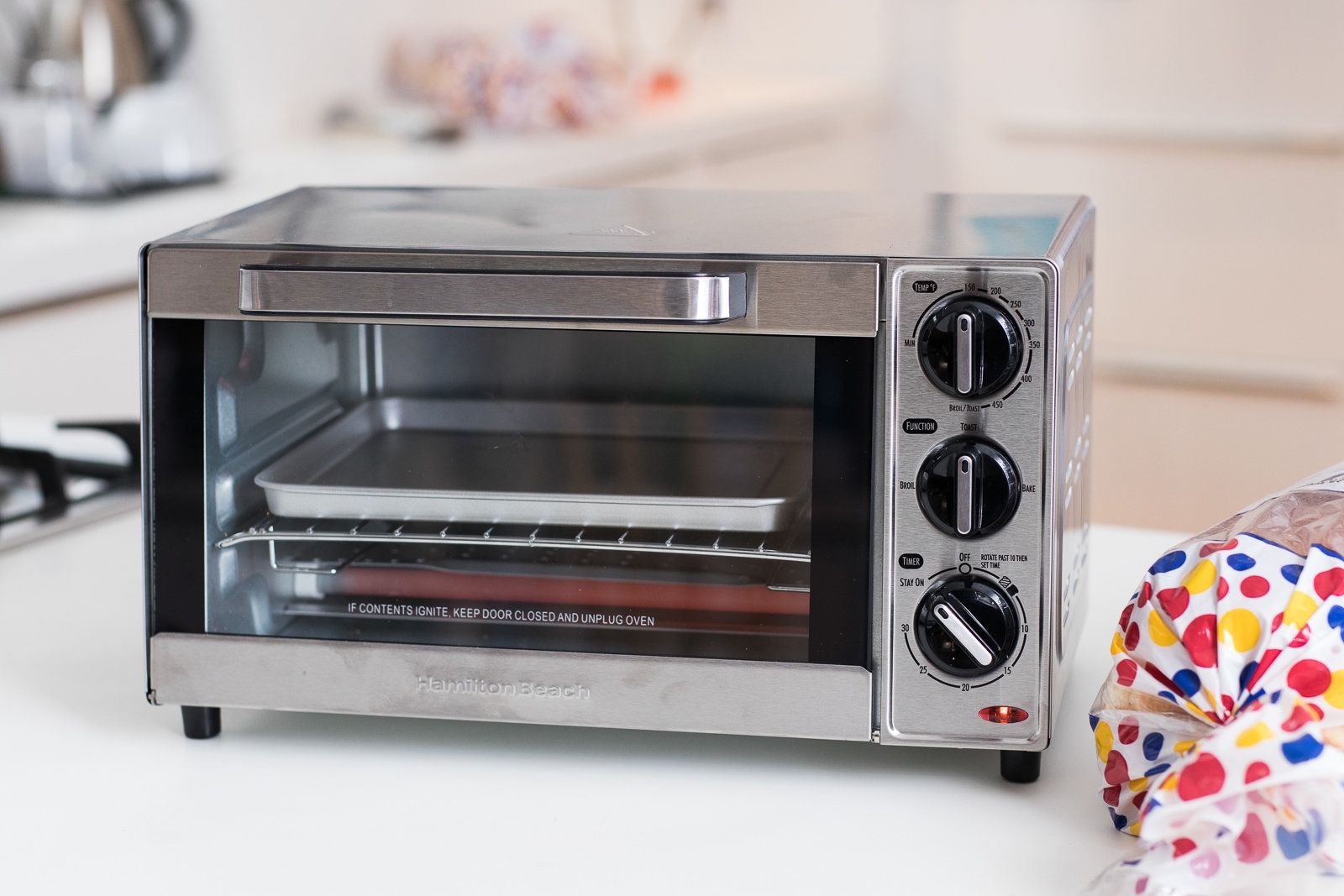
If our other picks have more features than you need, we recommend the inexpensive, no-frills Hamilton Beach 4 Slice Toaster Oven (model 31401). The Hamilton Beach’s two quartz heating elements toasted bread faster and more evenly than any other oven we tested less than $100. It three manual knobs to control the settings. While it lacks most of the features included in high-end models, such as preset cooking functions, a convection setting, and an internal light, it excels at the basics, like making toast, cookies, and frozen snacks. Its small footprint is ideal for kitchens with limited counter space. It has a few quirks that are expected with such a cheap model (such as running several degrees cooler than its set temperature), but on the whole we think they’re negligible.
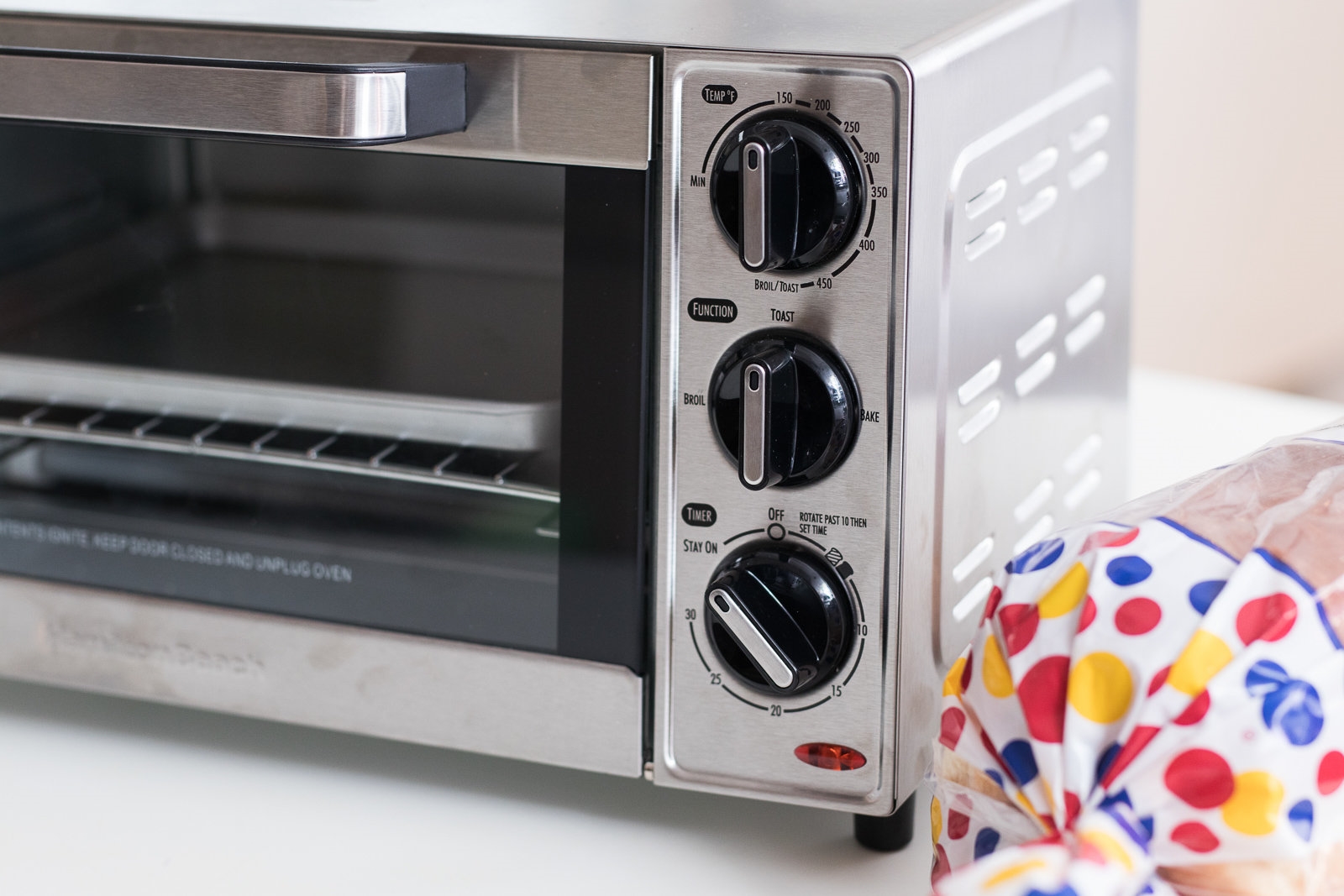
The Hamilton Beach has manual knobs that adjust the temperature (from 150 °F to broil/toast mode), the function (broil, toast, and bake), and the 30-minute timer. The biggest drawback to this model is the toast shade setting on the timer dial. You have to turn the knob past the 10-minute mark and then reverse it to the desired shade setting. However, it’s difficult to determine exactly where the dial should be placed for your preferred toast shade. Eventually, we were able to find the sweet spot on the dial for our desired doneness, but it took multiple attempts. That said, the toast came out remarkably even for a toaster oven of this caliber. Like most toaster ovens, the Hamilton Beach will get hotter after each batch of toast you make in a row. You’ll need to reduce the toast shade setting for each subsequent batch you make to prevent the bread from burning.
This model comes with the most basic accessories, including an oven rack, a baking pan, and a crumb tray. More advanced digital models will alert you once the oven is preheated to a set temperature, but the Hamilton Beach lacks this feature. The instruction manual recommends allowing five minutes for the toaster oven to preheat. That said, a charming, old-school ding does alert you when the timer goes off. We preferred this subtle sound to the ear-shattering beeps on some digital models, like the Wolf Gourmet Countertop Oven.
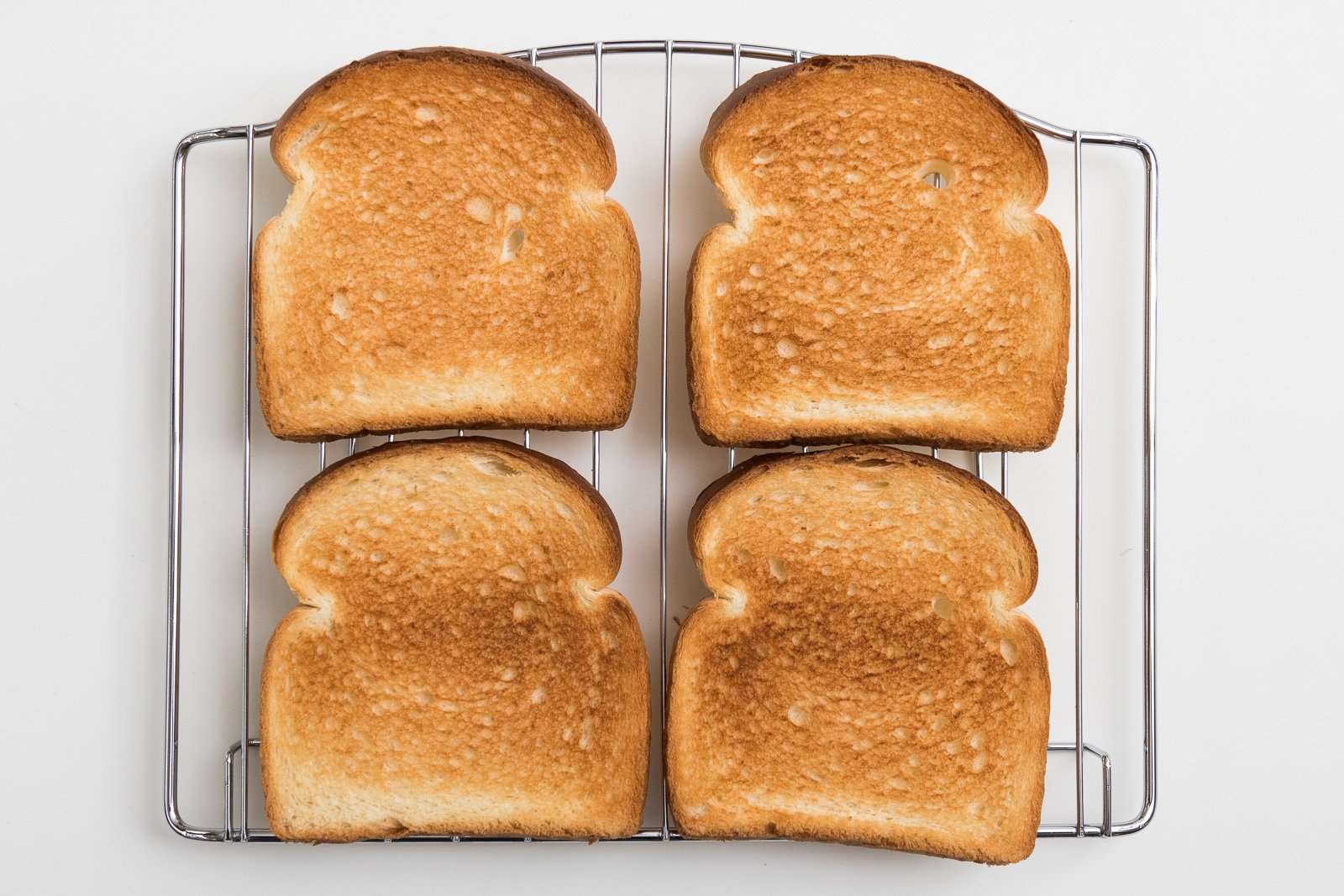
The Hamilton Beach runs cooler than other models we tested, so you’ll need to increase the temperature by about 25 degrees when baking cookies or snacks. However, we think this is a forgivable drawback considering its low price tag. The indicator light is a helpful feature that allows you to see that the unit is on, but we did notice it’s difficult to detect unless you crouch down to see it. The Hamilton Beach doesn’t have a strong spring mechanism to keep the oven door from falling open like our other picks. Be mindful of this when opening the door to avoid putting unnecessary stress on the hinge.
We’ve read some user reviews regarding food catching fire in the Hamilton Beach. Though we never experienced this in our tests, always be sure to place food at least 1 inch from the heating element. Also, clean the heating elements and the bottom of the unit before operating. An accumulation of crumbs and other food particles can burn and begin to smoke if not cleaned out regularly.
The Hamilton Beach 4 Slice Toaster Oven comes with a one-year warranty. Contact Hamilton Beach for repairs or a replacement.
Care and maintenance
To prep your toaster oven, you’ll need to run several cycles with the machine empty before using it to cook anything you plan to eat. This way, any industrial residues inside the oven (which are applied to prevent corrosion while the machines are shipped and stored) can burn off and don’t have a chance to get into your food. Do this in a ventilated space if possible; depending on the oven, you’ll smell fumes in the first round or two. While you wait, take the time to wash the rack and accessories in warm, soapy water.
Once you’re up and running, we recommend you empty the crumb tray often. To keep grease from dripping on the lower heating element, be sure to use foil and a pan underneath the item you’re cooking. If grease splatters inside the oven, clean the interior according to the manufacturer’s instructions.
It’s common for most toasters to release steam while toasting, so don’t be alarmed. This is a normal occurrence, especially if the bread is particularly moist.
The competition
Under $100
The Black+Decker TO3250XSB 8-Slice Extra-Wide Convection Countertop Toaster Oven hogs a lot of counter space. It toasted unevenly and burned cookies and Bagel Bites in our tests. Also, this model had difficulty maintaining its internal temperature.
The Black+Decker TO1332SBD 4-Slice Toaster Oven was the most inconsistent in our tests, burning some things and undercooking others.
The Black+Decker TO1303SB has low ratings on Amazon. We found that it was cheaply built, gives you little control over the the toast shade, and has a small interior space.
The Cuisinart TOB-40 Custom Classic Toaster Oven Broiler is easy to use, but bread became too dark on its medium setting. Also, this model has no timer, so you’ll have to keep a close watch on your food to prevent it from overcooking.
The Hamilton Beach Easy Reach Oven with Convection, Silver (31126) is popular on Amazon, but we weren’t fans of its lid, which opens up over the top of the oven instead of down. Many people with small kitchens store items like metal bowls or sheet pans on top of their ovens, and the lid prevents that. Also, its medium toast setting produced pale results.
The Krups Deluxe Convection Toaster Oven OK710D51 received high scores from Consumer Reports, but we found it didn’t toast evenly. However, it baked cookies and Bagel Bites well, and maintained a set temperature within 30 degrees. We also appreciated that is comes with multiple oven racks. Ultimately, we felt our picks performed better overall and don’t take up as much space on a counter.
We were underwhelmed by the Proctor Silex 4-Slice Toaster Oven. We dismissed this model because it was plagued by the same inconsistency problems as the Black+Decker TO1303SB model.
The Oster Large Digital Countertop Oven (TSSTTVMNDG) has cheap plastic components. In our tests, its performance was inconsistent and it had hot spots and high running temperatures. Consumer Reports gave it a score of 64 and chose it as its best buy in the category, but said, “The model’s overall toasting performance was only so-so.”
Between $100 and $200
The Breville Mini Smart Oven’s main drawback is that it toasted bread inconsistently. That said, it baked cookies and Bagel Bites well. It was also able to regulate its internal temperature surprisingly well. We liked this model overall, but in the end we dismissed it because it didn’t perform as well as the Panasonic FlashXpress and costs about $30 more.
The KitchenAid 12″ Convection Digital Countertop Oven (model KCO273SS) came with very nice racks and the clearest display of all the toaster ovens we tested, but it didn’t toast quite as evenly as our picks.
The Cuisinart TOB-135 toasted bread unevenly, and its temperature control was less consistent, so we were able to dismiss it.
$200 and up
The June Oven is a smart countertop oven with an internal camera, built-in probe thermometer that estimates when your food will be cooked through, and several preprogrammed cooking functions. The HD camera can recognize certain ingredients, automatically prompting the interface to recommend corresponding cooking programs. Plus, a Wi-Fi connection allows you to use an app to monitor your food with the camera and control the oven from anywhere in your home—or even miles away. For all these features, though, we were disappointed with the June’s performance, especially given its high price. We wish it had additional cooking programs and that the recipes were more enticing and better written. The camera is fun to use, but it doesn’t make cooking easier. And although the June is larger than most toaster ovens, its capacity is still limited compared with that of a full-size oven, especially if you plan to prepare food for four or more people.
The De’Longhi Livenza Digital Convection Oven did not toast evenly in our tests. It also had a difficult time maintaining its internal temperature (which fluctuated between 322 °F and 369 °F when set to 350 °F).
In our tests, the Smart Oven Air’s PID temperature control system impressively regulated the toaster’s internal temperature within just 5 degrees, but it made inconsistently shaded toast. This model also boasts a super convection air-frying mode and a dehydrating mode. Both of these features worked well, but we’re not sure how useful they are for most people. The frozen french fries we made using the Cuisinart TOB-260N1 were nearly indistinguishable from the fries we made in the Smart Oven Air. The dehydrating mode made perfect dried apple rings, but the oven cavity has the capacity to fit only three dehydrating racks (two of which need to be purchased separately). Also, each rack can only hold apple slices from about one and a half apples, which isn’t much. Since it’s so expensive, we’d recommend this model only for people who want to air-fry or dehydrate foods in small batches.
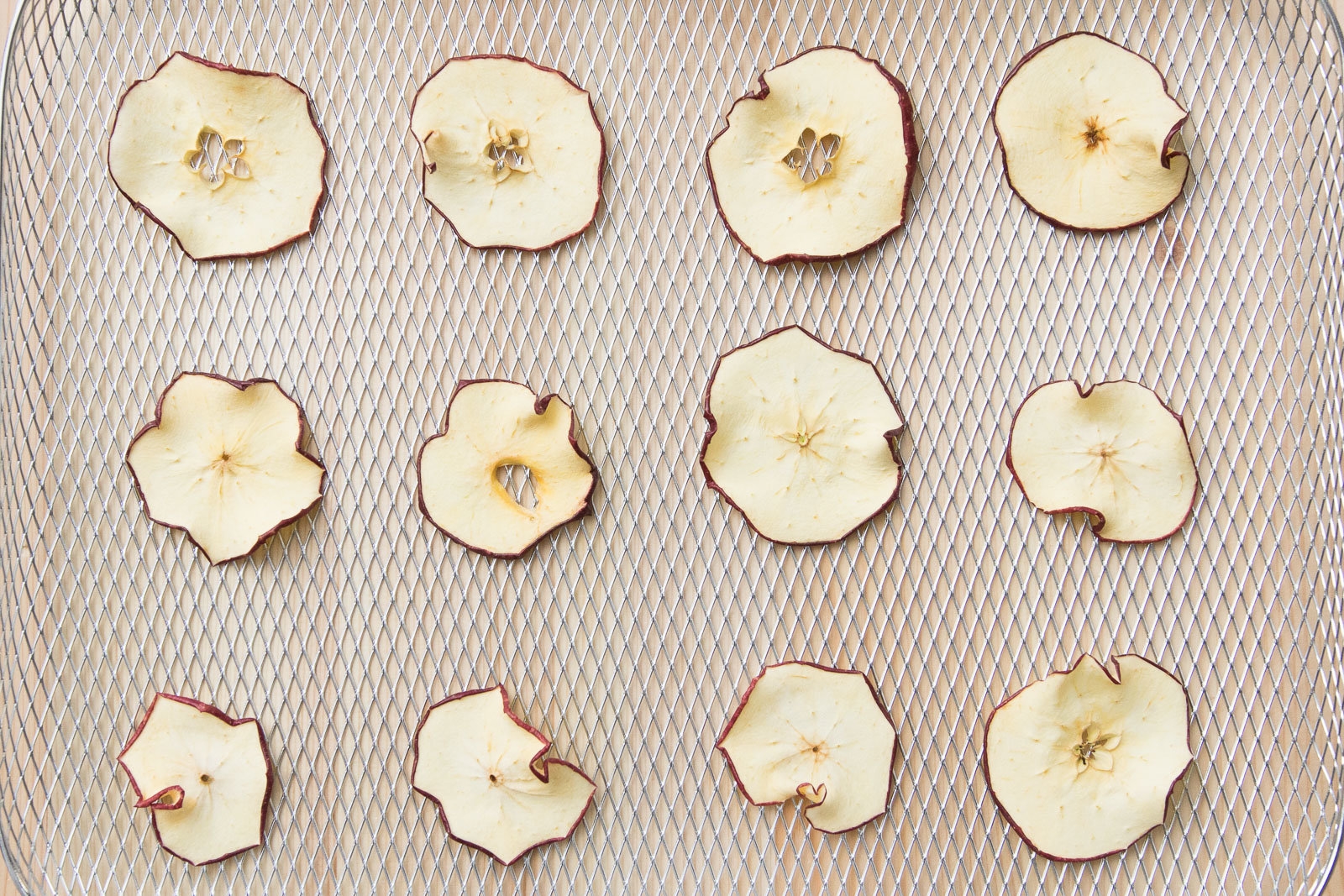
We appreciated the compact size of the Breville Compact Smart Oven (BOV650XL), but it didn’t do well in many of our tests. Its price is also more than the Panasonic, which we like more overall.
The Smart Oven Plus had low availability at the time of our testing, so we opted not to test it. It’s very similar to the Smart Oven Pro, which we’ve previously dismissed.
The Breville Smart Oven Pro is nearly identical to our runner-up pick, the Breville Smart Oven. While the Pro adds a couple of minor features (a slow cook mode and an internal light), the Bagel Bites we toasted between the door and the front of the oven’s rack were noticeably paler than those in the middle and back of the oven. Consumer Reports (subscription required) found the same thing, giving the Pro a lower score on “full batch” than the Smart Oven.
The exorbitantly priced Wolf Gourmet Countertop Oven produced the most evenly browned toast of any model we tested. Consumer Reports (subscription required) also gave it high marks. That said, it took about 7 minutes to get those unparalleled results. To be fair, it’s a countertop oven, not a toaster oven, so a slower cooking time is to be expected. But the Wolf was also slower to preheat than our picks. It took up a lot of counter space and beeped loudly too. We think it’s best for people who don’t have space for a full-size oven in their home, or for those who have a lot of counter space and need an additional oven.
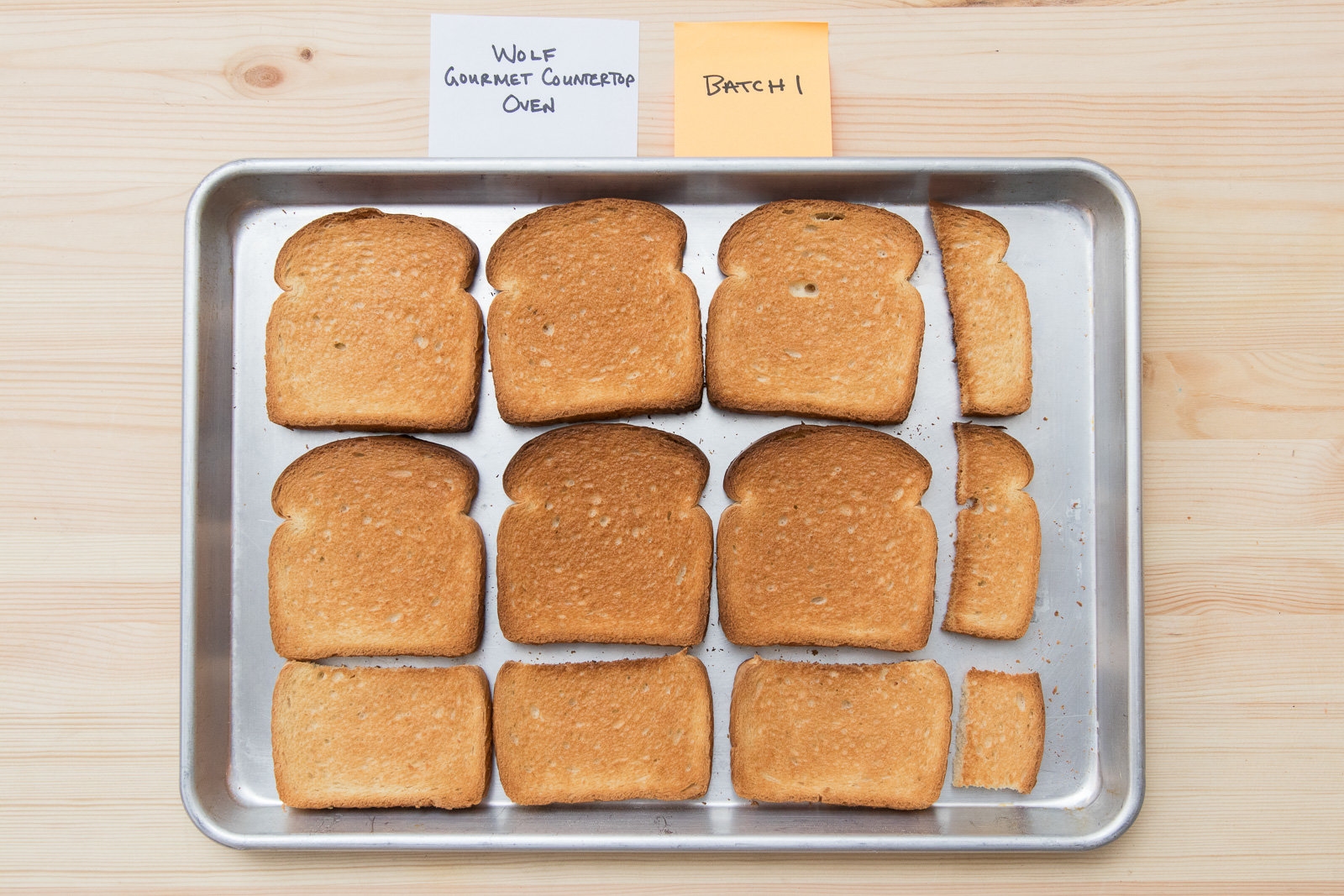
We opted not to test the new Panasonic Countertop Oven and Indoor Grill with Induction Oven (NU-HX100S) because it has received mediocre reviews on Amazon.com. The grill pan seems useful for indoor grilling, but multiple reviewers claimed it was difficult to clean. Other reviews indicate that this model takes an exceptionally long time to preheat and that the oven cavity is small.
The Cuisinart CSO-300 promises to speed up cooking times by at least 40 percent by incorporating steam heat. However, we didn’t test it because it’s more of a steam oven than a toaster oven.
This guide may have been updated by Wirecutter. To see the current recommendation, please go here.
When readers choose to buy Wirecutter’s independently chosen editorial picks, Wirecutter and Engadget may earn affiliate commissions.
(107)

